 By Pepper Parr By Pepper Parr
October 22, 2015
BURLINGTON, ON
Aldershot resident Tom Muir wrote Ward 2 Councillor Marianne Meed Ward asking her why the city missed the 180 day deadline it had to approve a development application. His first request was not answered – he sent a second request and copied the Mayor and the city Manager.
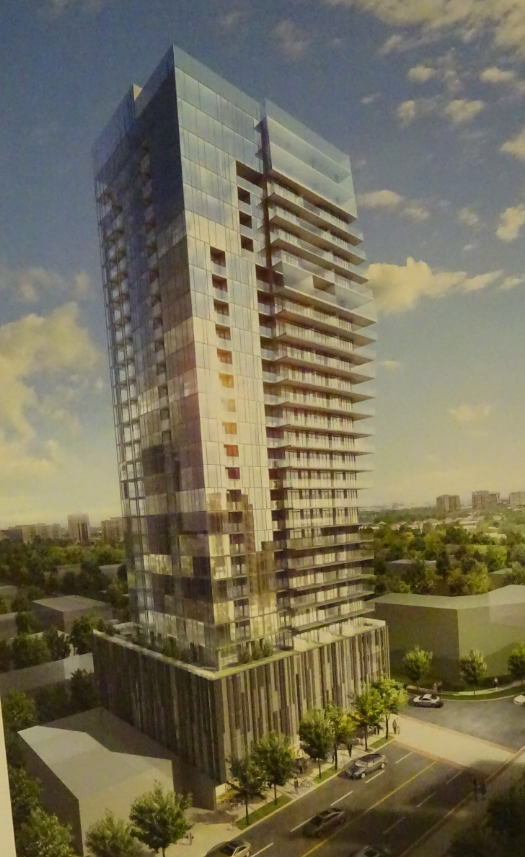 An architectural rendering of the 28nsorey tower the ADI Development group wants to build at the corner of Martha Street and Lakeshore Road The Mayor promised to get back to Muir with a “meaningful response” and asked him to be patient.
Meed Ward got back to Muir with the following:
Thanks for your inquiry and my apologies for the delay in responding. You raise a number of very important and thoughtful points, and these required time to provide an equally thoughtful reply. I trust you will not read anything into the delay other than it took some time to prepare. I acknowledge that it would have been helpful for me to simply acknowledge initial receipt of the email when I got it, and let you know I was working on a reply – I will do that in future so you know I am working on a reply and that it will take some time. My apology for not doing that in this case – I’m sure it would have helped.
As this is now a legal matter before the Ontario Municipal Board, I will attempt to give as full a reply to the issues without jeopardizing our case at the OMB and while maintaining confidentiality of any legal matters. The questions you have asked raise important issues of principle and I will attempt to speak to them at that level.
You ask why the 180 day time elapsed, allowing the developer to appeal to the Ontario Municipal Board for a “non-decision” within the legislated time frame. Based on the information I have received, and documented in the time line on my website, this file simply took longer than 180 days to process because of the complexity of the project and the number of agencies that needed to provide feedback. That often occurs with more complex files. We have dealt with several files at recent Development & Infrastructure Committee meetings that have gone beyond 180 days, and developers on these projects have been prepared to work with the city so long as they are assured the file is moving forward and being processed.
The timeline I provided in an earlier article helps to tell the story of the amount of work required on this particular application and that staff worked diligently throughout the process to complete the report in a timely fashion. The staff report had been prepared and the committee was four days away from a vote when the appeal was launched. Typically, an appeal is launched for non-decision when the city is dragging its feet on processing an application. That wasn’t the case here.
Nevertheless, I believe it is a worthwhile question of principle to ask in general: why isn’t every Official Plan Amendment and Rezoning application processed within 180 days and what would it take to make that happen? We know that most applications we will see in Burlington are infill, versus greenfield (having run out of large greenfield areas for redevelopment). We also know that these applications by nature are more complex and take more time to review. So we must ask: what changes would we need to make at City Hall to ensure we can nevertheless even process these more complex applications – all of them – within the timeframe?
It is a good question; you and other residents are raising it; and I have asked this of staff internally and we will continue to discuss this over coming weeks and months until we have some suggestions going forward. In my view, if the timeline is there we need to do what we can to meet it, and we need a better understanding of what it will take on these more complex files to achieve that outcome. I am committed to doing what it takes to achieve that outcome going forward.
You have also raised the question of whether the appeal for non-decision within 180 days impacts our position at the Ontario Municipal Board. A non-decision within 180 days is one route to the OMB; the other is disagreement with the decision by council on an application. It is worth noting that the staff report recommending refusal of this particular file was available before the 180 days elapsed. The developer knew staff were not in support of the project. So the question is: does it make a difference whether a file is appealed for non-decision within 180 days or because the project has not been supported by staff and ultimately council? It’s a good question and one that is being asked on behalf of residents by myself and council. I will continue to investigate this.
However, at the end of the day, the OMB makes its decision based on the planning merits of the application more so than by which route the file ended up at the OMB, whether it was because the 180 days elapsed or because of disagreement with the decision. The planning merits or lack thereof are primary matters for consideration. The city will present our case, outlined very well in the staff report, that the project does not meet the criteria for good planning. Those are the matters that will be considered at the OMB in rendering a decision.
Some residents have asked: does the fact that committee and council voted on the project after it was appealed have an impact on our position at the Ontario Municipal Board? The unanimous vote at committee, upheld by council, to support staff and refuse the project will be part of the information forwarded to the OMB when it is deliberating. So the voice of the residents, via your elected representatives, will be heard and will be part of the information presented at the board.
I hope this addresses your questions based on the information I have at this time, recognizing that this is an evolving issue and there are additional learning as we move forward.
Please be assured I am committed to exploring how we can meet the 180 day time frame for every application. City council relies on staff to give us professional advice and see us through the application process; we work together. So I am further committed to ensuring that council, city hall and our planning department take appropriate steps to learn from this situation. The dialogue has started and is continuing.
 Also be assured that my goal is the same as it has always been: to welcome and support development that respects our existing Official Plan and Zoning. As the staff report on this particular project states clearly – we do not need to overintensify this site or any other to achieve our goals and obligations under Places to Grow to intensify in the downtown area. I will continue to advocate on behalf of residents that we respect our Plan – and if it needs changing to do so within the overall context of an Official Plan Review which takes places every five years. Also be assured that my goal is the same as it has always been: to welcome and support development that respects our existing Official Plan and Zoning. As the staff report on this particular project states clearly – we do not need to overintensify this site or any other to achieve our goals and obligations under Places to Grow to intensify in the downtown area. I will continue to advocate on behalf of residents that we respect our Plan – and if it needs changing to do so within the overall context of an Official Plan Review which takes places every five years.
It has been gratifying that all of city council and city staff, and the vast majority of residents, have been united in our position that this particular application is not good planning, is overintensification, and needs to go back to the drawing board to come back with a more reasonable proposal in keeping with our existing planning goals for this site. As a community, we need to continue to stand together and make a strong case at the OMB to turn this down and seek more appropriate redevelopment on this site. I will continue to work with you, residents, city council and staff to see that through.
Whatever the outcome of this situation, city hall should always be reviewing and learning from major issues in our city as a standard practice and a matter of principle, to learn how we can be better. Please know that I am committed to undertake this review. That said, know that our first and immediate priority is to win this case.
Thank you for your contribution to this process.
Muir doesn’t buy the Meed Ward response and sets out the time line as he understands it.
Councillor,
Thank you for your message.
To cut to the quick, I must say that, sadly, you did not meaningfully answer my September 16 and October 8 requests to be informed about how the decision was arrived at to allow the 180 day period, mandated by legislation as default grounds for OMB appeal, to elapse before the Council vote was able to be made on the staff recommendation report on this project.
 Tom Muir, an Aldershot resident suggests the reasons ward 2 Councillor gave for the city’s failure to vote on an application development and asks: Did someone advise you to do this, or did you just drop the ball? As part of this request, I also asked a number of questions concerning the administrative management staff motivations and thinking that led to this decision. These questions were also not answered, and in fact, were never addressed.
Instead, your message is a narrative of excuses, rationalizations, and blame-shifting that does not fit the facts contained in the record of city proceedings and timeline in this matter. You also wrote several extended digressions, that collectively muddle, and side-step, the direct point of my inquiry.
I acknowledge that to some extent you are, as you say, basing your remarks on information you have received from others, and documented in the time line on your website, but there is no attribution on this, and of course, you are responsible for your choice of words. Whatever, I would be careful who you listen to in the future. They may be more interested in self than in you.
In evidence, we can consider the timeline you document in your March 31 website newsletter, and examine the city record of proceedings that are contained in this timeline.
Recall that the prescribed time frame or timeline of 180 days started on September 24, 2014, and elapsed on March 24, 2015.
Over this entire timeline there are a number of public meetings, and staff reports and correspondence available to examine in the proceedings, and there is no evidence that the working planning staff were not in control of the processing timeline, or found the file too complex to process in time.
In fact, the ADI project was generally opposed by the public, and the staff report was a thorough, fair, and strong planning based recommendation to refuse the application. There are no apparent complicating factors to make the file too complex or unwieldy to process on time, as you imply it was.
There is also no reason to expect that the refusal recommendation would lead ADI to be prepared to work with the city beyond the prescribed timeline, as you uncritically, and therefore misleadingly, state other developers might do if their application is moving forward.
I can’t imagine this happening in the face of a known refusal, and the staff record shows that ADI had no intention of negotiating changes. So you certainly can’t shift blame for the failure to meet the timeline to ADI for doing what they did, as you appear to.
I find your stated insinuation, that despite working diligently, staff were unable to overcome unspecified factors of complexity and time slippage, as you claim, and were only able to prepare the staff report 4 days before the Committee meeting date, incorrect, misleading, and totally unfair to the staff working on the file. They cannot defend themselves or set the record straight.
In fact, the timeline indicates that the staff recommendation report was presented to the then Director of Planning and Building, Bruce Krushelnicki, on March 2, which is 22 days before the 180 day timeline elapsed.
Then, the staff recommendation report was made public and sent to the Development and Infrastructure Committee on March 13. This means that the staff recommendation report was in Mr. Krushelnicki’s hands for 11 days.
One has to ask why this 11 days was needed if the planning staff process for the 180 day timeline was considered, as you claim, to be behind time, and if the responsible planning management staff was actually respecting the timeline. Did Mr. Krushelnicki really need 11 days to decide to support his staff, and where is the record of that decision process?
There is no apparent explanation of this seeming excessive use of time, given the situation, and its use as an excuse for the failure to meet the deadline of March 24.
What is also inexplicable is that the staff recommendation report was scheduled to be presented to the D&I Committee on March 30, and to Council on April 20, absolutely too late in the circumstances, and guaranteed to facilitate an ADI appeal to the OMB.
Even more inexplicable is that there was already a scheduled Council meeting for March 23, obviously 1 day before the 180 day timeline elapses, and this opportunity for a Council vote on the proposal was squandered with nary a mention.
Knowing all this on March 13, and before, the staff recommendation to refuse could have been scheduled for the March 23 Council agenda. The Mayor has authority to get this done. Why was this not done? Who is responsible?
Despite all this, four supposedly responsible senior managers ( Bruce Krushelnicki, Director of Planning and Building; Blake Hurley, Assistant City Solicitor; Scott Stewart, General Manager of Development and Infrastructure; and Nancy Shea Nicol, Interim City Manager and Director of Legal Services), who would have known all these facts – the expiry of the 180 days on March 24, and the already scheduled Council meeting on March 23 – still signed off on and approved the said, far too late, meeting dates for the staff recommendation report to get to Council.
In effect, this decision left the back door open for ADI to appeal on the easiest of grounds. The will of the public, and the staff recommendation report, were dead on arrival at Committee, and this seems to have been done on purpose.
What were these managers thinking or not thinking? Is this a deliberate action, taken regardless of the consequences for the city and public trust, or just stupid non-thinking?
Or is it worse, a case of creative bungling that sabotages the city interest and control over the rational planning of development within the existing OP and policy prescribed framework? This situation could do a lot of damage to the aspirations of city residents to develop according to a plan and process they have chosen.
How can we trust the legal department to present the city case at the OMB when they participated in this unbelievable muddle – headedness? They took the city’s legal right to decide on this development proposal and to refuse the application, and gave it away to ADI, and someone from the OMB to decide. Now what they want to do is confidential, and things are done in secret, and in camera.
 Nautique – the ADI Development Group project is being heavily marketed with a number of real estate agents offering the units for sale even though the development is the subject of an OMB hearing. Is this what the public is supposed to trust and have confidence in as proper, credible administrative implementation of the rules, regulations, and laws?
Tell us please, how this decision to kill the staff refusal recommendation, at delivery, serves the public and city interest? I want these managers called to account for how the interests of the city and residents are better served by what they have done in this case?
These points are what most of the other questions in my October 8 reminder message were asking. The responsible staff managers need to be called to account for what they did.
In all of this there is a role for the members of council, but particularly yourself, the Ward 2 Councillor, who would know, or be expected to know, all about what I have described here.
You knew about the March 24 expiry date of the 180 day prescribed time frame, and that the scheduled Committee meeting, and particularly the required Council meeting, where the staff recommendation report was on the agenda, were too late to ensure that the will of residents, and staff, met the planning rules and was therefore legally valid.
And yet you remained silent, and went along with what was happening, and what eventually did happen.
Why did you do this, remain silent?
Did someone advise you to do this, or did you just drop the ball? You are still going along with it, and actually making excuses and rationalizing in support.
You are even musing that maybe the killing of the city will on this development, and the forced OMB hearing, are not such bad things. This is beyond denial, bordering on delusion brought on by the forced acceptance, without protest, of the unchangeable nature of what has happened.
I could go on here and try to address the several digression aspects of your message, but that discussion does not really fit here, and are not what my initial inquiry and messages were asking about. One exception is about what I termed to be a gold rush and unethical mentality, using lies in advertising, and other selling activities, to promote projects that are not approved and at the OMB.
I will only say that if the city does not have bylaws restricting such promotions and advertising of unapproved project proposals, then the city should have one, and has the power to enact one. I suggest this as another policy development digression to add to your list for discussion.
It can get worse, and it is, as exemplified by a project on Plains Rd in Aldershot that advertises a 6 story, 75 unit condo, in preconstruction and coming soon, in an area where it is not permitted in the OP and zoning bylaws, and for which there is not even an application. Nothing is being done by the city about that developer behaviour either, and it is in fact being condoned.
We are on a very slippery slope, poised to lose control of development and our OP to speculators. The ADI situation is a test case that is being closely watched to see how easy it will be to bust Burlington’s Official Plan wide open.
Yours sincerely,
Tom Muir
Is there going to be another round to this argument?
And is Tom Muir ever going to see the “meaningful response” promised him by Mayor Goldring? Or does the Mayor feel he has a 180- day time line.

 By Pepper Parr By Pepper Parr
October 15, 2015
BURLINGTON, ON
It took a while but after a solid search and some internal wrangling to determine how much influence the Chief Magistrate would have over the choice of a new planner for the city municipal planning veteran Mary Lou Tanner, was been named as the City of Burlington’s new Director of Planning and Building effective Nov. 2, 2015.
Tanner is currently the Chief Planner for Niagara Region and was Acting Commissioner of Planning and Development Services for Niagara Region. With over 25 years of experience working in the public sector, Tanner has previously worked at the City of Hamilton and Halton Region where she held a variety of planning roles and led infrastructure planning in public works.
 Mary Lou Tanner will join the city on |November 2 as the Director of Planning. “Mary Lou is one of the top planning directors in Ontario and brings extensive municipal expertise to this role,” said Scott Stewart, the city’s general manager of development and infrastructure. “Throughout her career, Mary Lou has successfully led many large, complex projects with multiple stakeholders — her seasoned background will be a valuable asset to the City of Burlington.”
Stewart is the person who made the hire – these comments are expected from him.
Tanner served as the President of the Ontario Professional Planners Institute from 2011 to 2013 and has received numerous national and provincial awards for planning practice.
Tanner is a graduate of the Planning School at Queen’s University.
Scott Stewart will continue in the role of Acting Director of Planning and Building until Mary Lou Tanner begins with the city on Nov. 2, 2015.
With Tanner in place the city now has someone who is going to have to move at the speed of light to get caught up on where the city is with its Strategic Plan – which is now close to six months behind.
The Strategic Plan will inform the direction the city goes with its Official Plan Review which has been put on hold until the Strategic Plan is in place.
Tanner will lead a department that has some very good people in place but some problems with the “front desk” where contractors have to go for the various permits they need.
She would appear to be well connected in the region – let’s see what we can learn about this newest arrival to city hall.

 By Pepper Parr By Pepper Parr
October 13, 2015
BURLINGTON, ON
Why is it so difficult to get answers out of city hall?
Tom Muir wrote Ward 2 Councillor Marianne Meed Ward asking why she had not said something publicly about why city council did not manage to vote as a council against the proposed ADI development at the corner of Lakeshore Road and Martha Street.
Muir sent that information request in September 16th and said at the time that he asked for “an explanation of how the staff report on this ADI project did not make it to Council within the 180 days mandated in the legislation as default grounds for OMB appeal.’
He didn’t get a response and repeated his request.
His original request was set out in an email he sent to Meed Ward, the Mayor and the city manager.
On Thursday, October 8th Mayor Goldring responded to Muir with the following:
Hi Tom,
You will receive a meaningful answer.
I was away recently for 10 days and am obviously behind in responding to some emails as well.
Please be patient.
The Mayor has been away – in China – which is significant from an economic development aspect – and the city has not heard a word about that trip. That is another matter.
Meed Ward also said she would respond but Muir has apparently not heard from her yet. Her response has been to refer people to her Newsletters of March31st and September 16th.
Most people the Gazette hears from find the content of the two newsletter confusing.
 Aldershot resident Tom Muir wrote city hall on September 16th asking for an explanation as to why the city failed to get a response to a developer within the 180 day mandated deadline. The issue for Tom Muir was – how did the city fail to vote officially on the Planning department recommendation not to approve the development application.
Everyone at all concerned with the project new that when the 180 day deadline was reached ADI would be going to the OMB and asking them to approve the project because the city had failed to provide an answer within the 180 day deadline.
 The ADI Development Group sought permission to put up a 28 storey structure on a small lot at the corner of Lakeshore Road and Martha. The city’s planning department put some of their best people on the review of the project and delivered a sound report that said the project should not be approved.
That report went to the Development and Infrastructure Standing Committee where members of Council voted unanimously against the project.
That recommendation from the Development and Infrastructure Standing Committee is just that – a recommendation.
Recommendations from the Standing committee have to go to Council to become effective.
 This city Council never got the opportunity to vote against a proposed development within the 180 days they were required to do so. Many people in the city want to know why this happened. The Mayor has promised a “meaningful answer” six months after the event. Every member of Council will tell you that they are free to change their minds and the vote they cast at a Standing Committee when a report and recommendation gets to council.
The city’s Planning department was fully aware of the 180 day deadline.
Council meetings are scheduled on a meeting cycle that is public – but, and this is significant – Council can meet at any time at the call of the Mayor.
That the Mayor did not call a Special meeting of council is inexcusable. Had the Mayor done his job and called a Special meeting of Council the city’s position before the OMB would have been a lot stronger.
There still would have been an OMB hearing – but the grounds for that hearing would not be that the city failed to respond.
There are those who are saying the will of the city was clear at the Standing committee – and it certainly was – but that will has no standing until the city council votes on it.
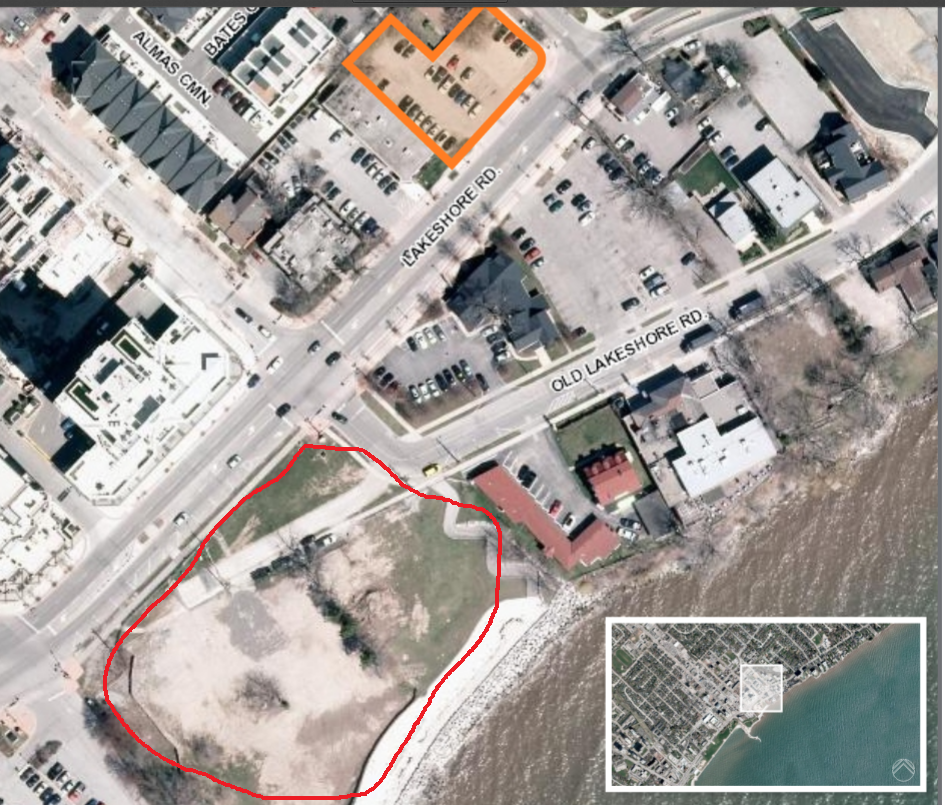 The ADI development is shown in the upper right, outlined in orange, the Bridgewater development that will break ground in earlier 2016 is shown in the lower left in red. All that happened on March 31st 2014, when Paul Sharman, Chair of the Development and Infrastructure committee advised the public that a summary of a planning report would be read but the city would not be voting on the matter because ADI had taken the matter to the OMB.
It is only now that we are hearing the Mayor say:
You will receive a meaningful answer.
Please be patient.
And so a cranky constituent waits patiently while the Mayor prepares a meaningful response – will the Mayor make a public statement on just how he failed to call a Special meeting of his Council and vote officially on this issue?
Or will Tom Muir have to send that response to the Gazette so we can make it available to the public?
This kind of situation crops up again and again with the Mayor and his Council.
There are many in the city who are concerned about what will happen at the Ontario Municipal Board hearing that is due to take place before the end of the year.
It is going to be a tough fight and there is no guarantee the city will win it.
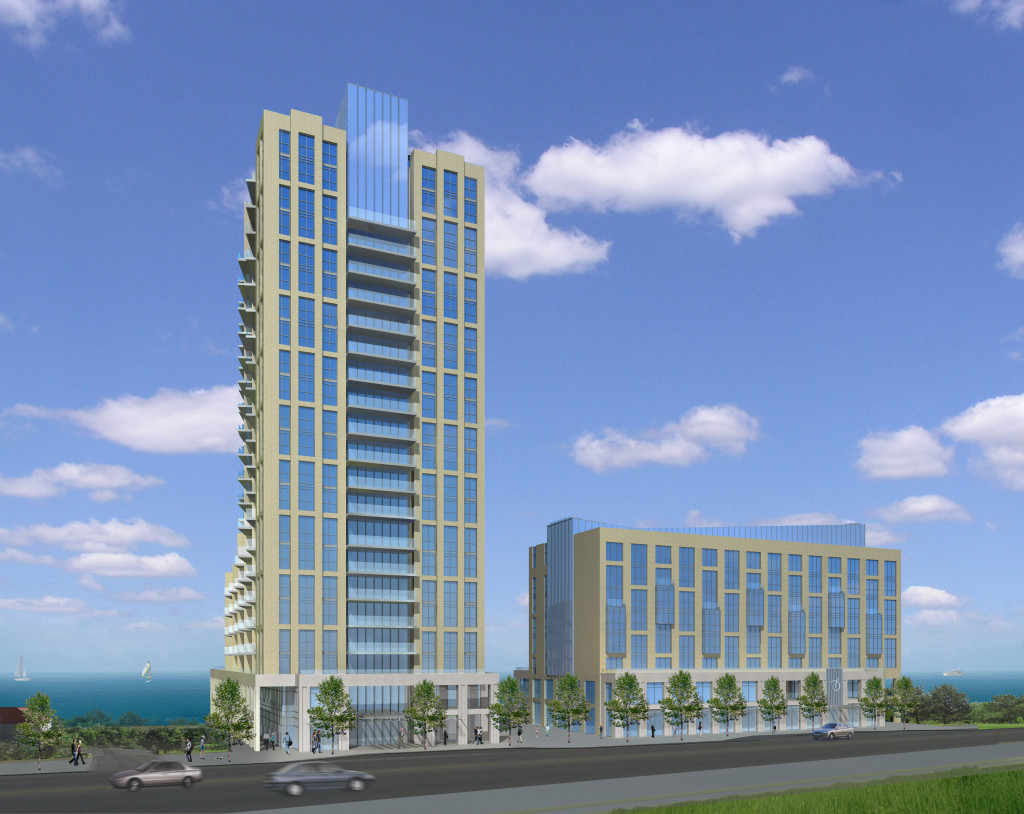 Two blocks away from the site where ADI sought permission to build a 28 storey structure the city approved the building of a 22 storey tower that will break ground in January. There is a 22 storey structure two blocks away – the Bridgewater development that will break ground in the New Year. Expect ADI to argue that they are as relevant to the development of the city as the Bridgewater project which was initially approved in 1985.
Far too many people have the sense that this Mayor does not have a firm grip on what the city wants and that he has not grown into the job of Mayor in his second term.
The Gazette interviewed Mayor Goldring when he was running for re-election in 2014. We were stunned at what little he had to say during that interview which took place in the offices of Rick Burgess, a Burlington lawyer who once for Mayor.
During that interview Goldring didn’t give any sense as to what he wanted to do in his second term. At the time it looked as if he was going to be acclaimed.
When Peter Rusin decided to run against the Mayor – the game changed quickly and Goldring had to scramble to find a campaign office and then raise the funds needed to run a campaign.
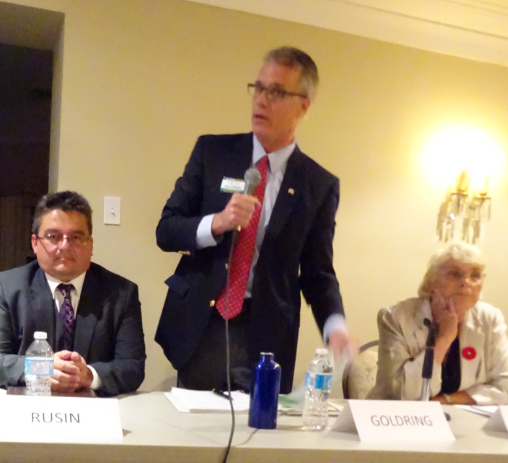 Mayor Rick Goldring speaking during a municipal election debate when he had to run against Peter Rusin and Anne Marsden There was no comparing Rusin with Goldring. While the Gazette doesn’t think Goldring is doing a very good job – and that view is supported by a significant number of people with standing in this city – Rusin would not have been an improvement.
Anne Marsden ran against Goldring but was never a contender – she was a place for people who were dissatisfied with the Mayor to park their vote.
The Mayor no longer talks to the Gazette – he does not answer emails and we are not able to make appointments with him
When the Gazette was finally able to speak with Mayor he said that he would not talk to us because he felt we were unfair and biased.
That is a legitimate comment – however, Rick Goldring is the Chief Magistrate in this city and that position and title does not allow him to behave like a petulant little boy.
 The last Mayor to refuse to talk to media was Rob Ford of Toronto – a rather embarrassing comparison for Burlington, If he has a concern – he has the responsibility to meet with us and set out those concerns. The last Mayor to do something like that was Rob Ford in Toronto.
There is more to say on how this Mayor behaves – right now we are waiting to see what his “meaningful answer” is going to be and why it has taken so long for some kind of statement from city hall.
The city would also like to hear what the Mayor actually did in China?

 By Pepper Parr By Pepper Parr
October 9, 2015
BURLINGTON, ON
Tom Muir is an Aldershot resident who takes what goes on in his community seriously – he is a major thorn in the side of Rick Craven, the council member for the ward.
 Aldershot resident Tom Muir is a strong believer in community participation in how the city grows. He has issues with the way city council failed to do its job.,
Muir has been wanting to know how the city ended up facing an Ontario Municipal Board hearing over a development that was proposed for the Lakeshore Road/Martha Street intersection in the downtown part of the city.
Muir had written Ward 2 Councillor Marianne Meed Ward and copied the Mayor and the city manager in the middle of September about the matter and thought he deserved at least an acknowledgement. As Muir explains it “I asked for an explanation of how the staff report on this ADI project did not make it to Council within the 180 days mandated in the legislation as default grounds for OMB appeal.
“My initial message was sent to Ward 2 Councillor Meed Ward, where the proposed project is located, and cc’d Mayor Goldring and City Manager James Ridge
Muir says he find it disturbing that his initial message has been completely and inexplicably ignored by Councillor Meed Ward.
Not on to be easily deterred Muir wrote a follow up letter asking to be informed about how the decision was arrived at to allow the 180 day period, mandated by legislation, to elapse before the Council vote was made?
“Whether it was deliberate or inadvertent, an explanation to inform citizens is warranted” said Muir.
“I have reviewed all of the pertinent content of the newsletters put out by Councillor Meed Ward, dated March 31, and September 16. There is no explanation there addressing my question; the latest newsletter commentary reads like the decision to let the timeline elapse did not happen.”
“What is written there rationalizes, and pardons, this failure to meet a deadline that triggers an automatic legal grounds for appeal to the OMB. It further denies that this failure matters, or is of consequence, and tries to project the blame for the predictable outcome on the developer ADI.”
Muir points out that the 180 day deadline was not legislated for nothing, so you can’t blame ADI for pursuing their legal rights. The fault lies in the city letting this happen.
The process timeline included in the March 31 Meed Ward newsletter shows that the city planning department recommendation for refusal of the ADI application was made public, and therefore provided to ADI, more than a week before the 180 day deadline. “In this situation” said Muir, “it is irrational planning management for the city to then fail to meet the deadline.”
“The city failure to meet this 180 day deadline is a major victory for the aggressive approach of ADI. It gives them an automatic appeal standing with the OMB, a very valuable legal right.
 Aldershot resident argues that the city’s failure to act properly on a development application almost legitimizes signs like this. “Further, it apparently legitimizes the several marketing activities they now have underway. These too are aggressive, speculative and misleading.
“These go beyond the controversial billboard on the proposed building site, and the storefront on Brant St being opened by ADI, advertising they are open for business for registration of purchases of “Lakefront Residences”, in what is called “Nautique”.
“Further, for example, I received a post card size advertisement in the mail, from a Loyalty Real Estate Brokerage, selling the ADI project address, but it is called a “Burlington Condominium”. It promises numerous project features, VIP first access, huge discounts, no lineups, instant gain on purchase, and wide selection of units.
“As well, in the Hamilton Spectator real estate section, New Home Living, dated October 3, ADI is advertising “Nautique”, as “arriving soon” and invites registration. Again, it is obviously the proposed project.
“This is spectacle, and where it will lead is assuredly to nowhere good for the city and citizens. It reminds me of a gold rush promotion mentality where shares in a mine site – in this case a patch of pavement and dirt – that has been salted, but not proved, are being hustled for sale.
“It begs the question of what the responsible city staff were thinking to surrender control of this development situation to ADI? What kind of city organization would allow this to happen?
“What kind of development planning strategy and tactics, and business plan does this action entail?
This appears an illogical retreat from a position of dominant planning argument, strength, and public support.
“What is the rationale for revealing, then folding a winning hand, thus letting ADI outflank the city, go straight to the OMB, and then use this to market what they failed to get the city to approve on official planning grounds?
“It could constitute city hall actions based on something sensible, or maybe worse, but how will we ever know with no information and transparency? It really needs inquiry, and needs to be visible. Transparent decision making processes are part of the foundation of the good governance of a municipality.
“You all know your duties and responsibilities under legislation and policy, and I will not read you chapter and verse, but just give a taste that is most relevant here.”
Section 224, subsection (d) of the Municipal Act is a good starting point. It outlines the role of the municipal council as follows:
“224. It is the role of council,
(d) to ensure that administrative policies, practices and procedures and controllership policies, practices and procedures are in place to implement the decisions of council;
(d.1) to ensure the accountability and transparency of the operations of the municipality, including the activities of the senior management of the municipality;” (my emphasis)
 Aldershot resident Tom Muir wants city council to do the job the Municipal Act requires them to do. He’d also like an explanation as to why they appear to have goofed on the ADI development application. The Municipal Councillors Guide 2014 states that ,”Clearly, accountability and transparency are a priority in maintaining public trust in council and in the management of your municipality. Section 224 of the Act explicitly includes ensuring the accountability and transparency of the operations of the municipality as part of the role of council.” Control and responsibility are other givens.
Muir, who doesn’t give up on issues that he thinks are important adds the “Burlington Citizens Engagement Charter contains similar and identical text, and city commitment and policy. As does the draft Code of Conduct, approved by Committee, and passed to the City Manager by Council for inclusion in the Strategic Plan. You can add in the Oath of Office that Council members take.”
Muir sums up his most recent letter saying: “I hope that you can see your fundamental responsibilities, both legislated and policy, in this matter of providing the explanation I have asked for.
“It’s your duty to ensure the transparency and accountability that underlie credibility and trust.”

 By Pepper Parr By Pepper Parr
September 28, 2015
BURLINGTON, ON
Have we seen this before or as the late Yogi Berra put it – “It’s like deja-vu, all over again.
On Wednesday, June 24, 2015 at the West Plains United Church there was a community meeting at which the city’s planning staff set out a proposal that had been submitted by the ADI Development Group for the development of land that was south of the rail line, east of Waterdown Road and immediately north of Masonry Road
 Some site preparation works seems to be taking place on that part of the property that will be stacked townhouse along with back to back townhouses. It was a staff presentation and the first time the community got a look at what the developer had in mind. Using the language of the planner it was an application to subdivide a 5.09 hectare parcel of land located south of the CN Rail tracks on the east side of Waterdown Road.
The subdivision design includes a road running north/south, extending north from Cooke Boulevard, and a 3.08 hectare development block on the east side of the proposed road.
Proposed development for the development block includes 200 stacked townhouses, 64 standard townhouses and 60 back-to-back townhouses.
The ADI Development group put the plan forward. At the time they were looking for site plan approval and a plan of sub-division.
At that time people in the audience expressed some concern over the lack of amenities – that same concern existed within the planning department and additional discussions were expected to take place.
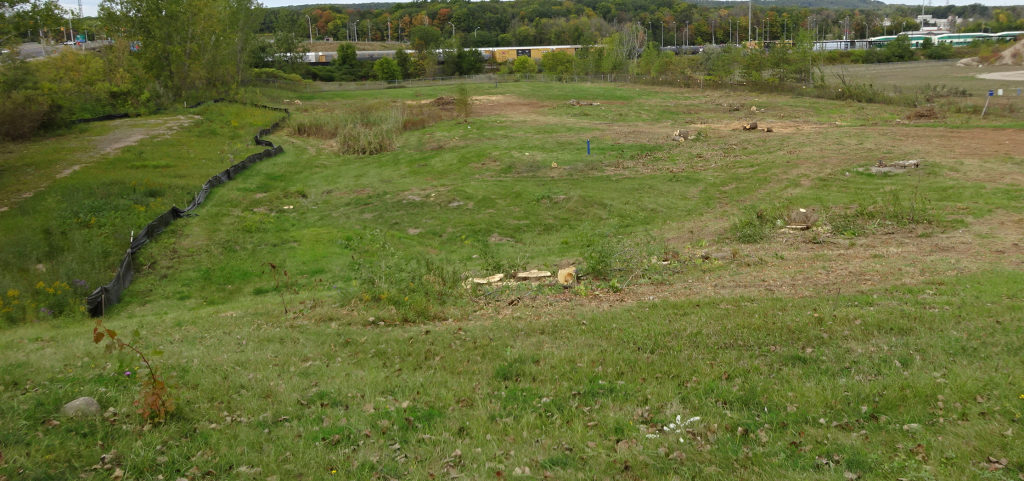 Just to the west of the stacked townhouses is the land on which the ADI Development groups is believed to want to build apartments in the future. The apartments would be close to the new re-build and widened Waterdown Road. Since that public meeting took place ADI withdrew their plan of sub-division. City planners issued comments for the developer – those comments are not public – they are comments made by the planners setting out the concerns they have and what it will take to ameliorate those concerns.
The planning department is expecting a revised site plan and perhaps a plan of condominium.
 The content of the sign is perfectly legal – putting them up around the community without a permit on the weekend when the city tends not to enforce the bylaw isn’t kosher. Sprouting up like weeds in the Aldershot community are A frame signs marketing the site – five of these signs were seen along Plains Road on Sunday. Is a project that has yet to be approved being offered for sale? No – all ADI is doing is letting people register their interest in a possible purchase when the project has been approved.
It is an excellent way to gauge buyer interest in both the layout and design and the price point. All good marketing. The people in ward 2 where the Nautique project is now before the Ontario Municipal Board (OMB) take heart with the Yogi Berra quote “It’s like deja-vu, all over again.”
To date there have been no revisions to the proposal and a Statutory Public Meeting has yet to be scheduled.
Stay tuned!

 By Pepper Parr By Pepper Parr
September 21, 2015
BURLINGTON, ON
Part 1 of a 2 part feature.
The day any one of the Bridgewater developments is opened – you may not see much of Jeff Paikin – he will be quietly walking from location to location polishing a door knob, picking up a piece of scrap paper or chatting up one of his neighbours. Paikin is not only the builder of the three structure project – he is also the owner of one of the condominium units
The project has been in the works since at least 1985. Paikin wasn’t the designer, the vision wasn’t his but a series of circumstances dropped the project into his lap and he is like a kid with a new toy.
 The Bridgewater is going to be a sterling project – because that’s what Paikin builds. The Bridgewater is going to be a sterling project – because that’s what Paikin builds.
The Gazette was taken on a tour of the sales office – parts of which are a built to scale of several of the rooms that will be located between the 9th and the 16th floor.
In the middle of the sales office is a very large model of the project which gives a great view of what the buildings will look like and how they will impact the city.
And they are going to impact the city.
Let’s start from the outside and work our way in – the sales office will be used for a Christmas party being given for the people who have purchased units – this will be a very high end – someone who is being asked to pay more than $3 million for the top floor of the 22 storey condominium – those are big bucks – and you don’t serve those people peanuts and cheap beer.
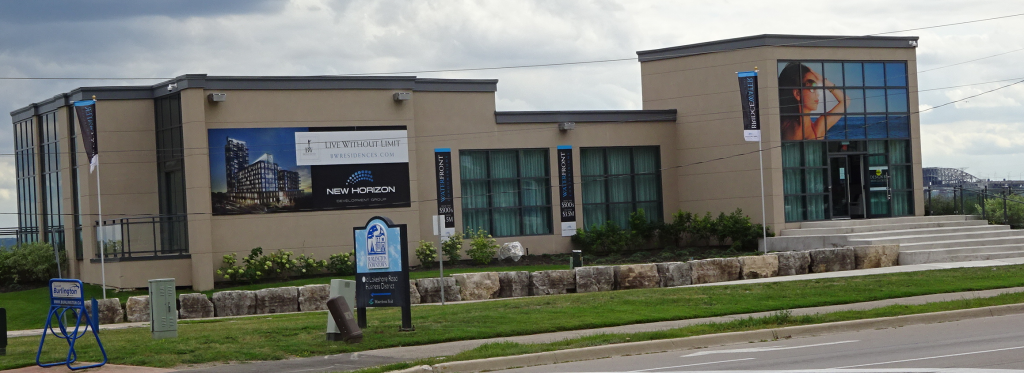 When the party is over – the sales office gets taken down – not by a bulldozer – it was built to be taken apart, stored somewhere and used again. When the party is over – the sales office gets taken down – not by a bulldozer – it was built to be taken apart, stored somewhere and used again.
Days later – the shovels go into the ground.
Expect it to be the photo op of the century for Burlington.
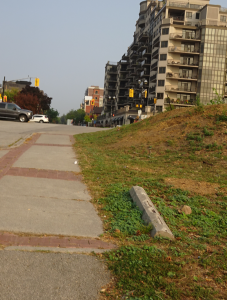 Elizabeth Street as it is today – it will be re-graded but still steep. The entrance to all the parking and lower access to each building will be at the bottom of this grade. There won’t be much seen by the public for a couple of months once the cameras and the television people leave the site.
The project is going to have four floors of underground parking including a level that vehicles will come into at grade – but that grade will be at the bottom of Elizabeth Street.
You can just imagine what kind of a photo op the putting of shovels into the ground is going to be. If the Mayor does a selfie – we hope it is better than the one he did on the bus several months ago.
While the Bridgewater is being constructed, just a three minute drive to the west the Joseph Brant Hospital expansion and re-development will be going on. Burlington actually has cranes on the skyline these days.
The Waterfront hotel is in the process of going through a design exercise that may see the existing hotel torn down and a much higher structure going up (more than 28 floors?) along with two smaller structures that will be located south of the current foot print.
The decision as to what can be done south of the current hotel sits in the hands of the Conservation Authority.
The design exercise has the city ordering up two designs and the owner of the property putting forward his own preferred design.
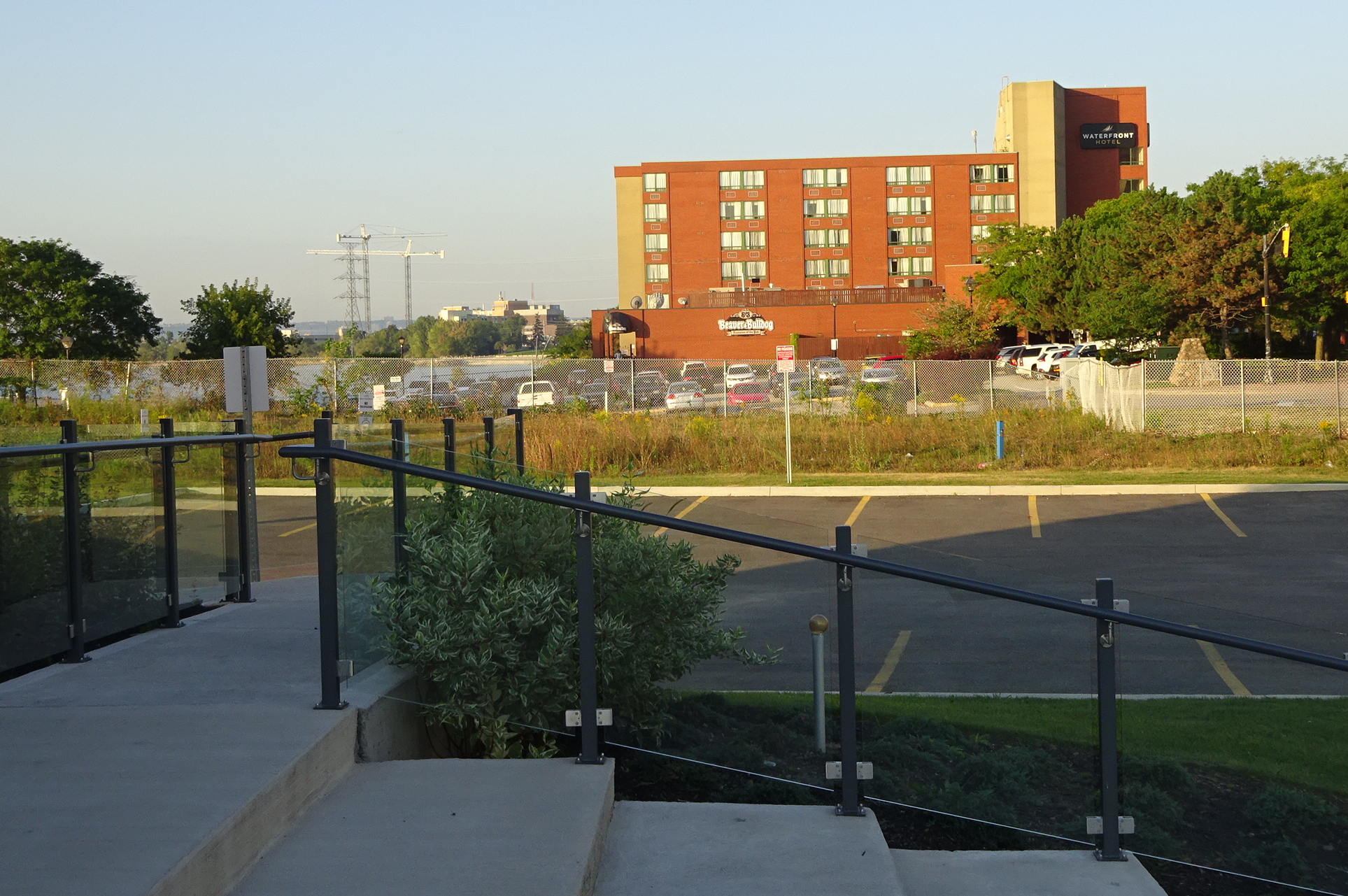 The view from the steps of the Bridgewater sales centre has two cranes on the horizon lifting buckets of concrete as the redevelopment and expansion of the Joseph Brant Hospital progresses. The Waterfront hotel in the foreground is in a redesign stage. Those three projects, the hospital, the Waterfront Hotel and Bridgewater will result in a downtown core that most people in this city are not aware of and many may not be ready for – but they are coming.
We step inside the sales centre – this is a “by appointment only” operation, you realize you are in what amounts to a two bedroom unit that is lavishly decorated by Brian Gluckstein. Everything is real not a piece of plastic in sight.
In part two of this feature we take you through the layout of the rooms and the design features – expect to see this location in one of the higher end design magazines.
When we last met with Jeff Paikin he had five sales situations in the pipeline – three of those came through and last week he booked $3.1 million in sales. Very nice.
The first thing you see at the sales centre is a large model of the project – “that cost $40,000” claims Paikin. It could have – it is big enough.
When the sales centre gets taken apart the model gets tossed – the Gazette has some ideas for that. Stay tuned.
The grade from the street level to the walkway at the edge of the lake is steep – quite steep and must have been a challenge to the landscapers.
 In order to keep open space for the public to enjoy between the hotel and the condominiums several sets of stairs are in place at the south end – they look steep. In order to keep open space for the public to enjoy between the hotel and the condominiums several sets of stairs are in place at the south end – they look steep.
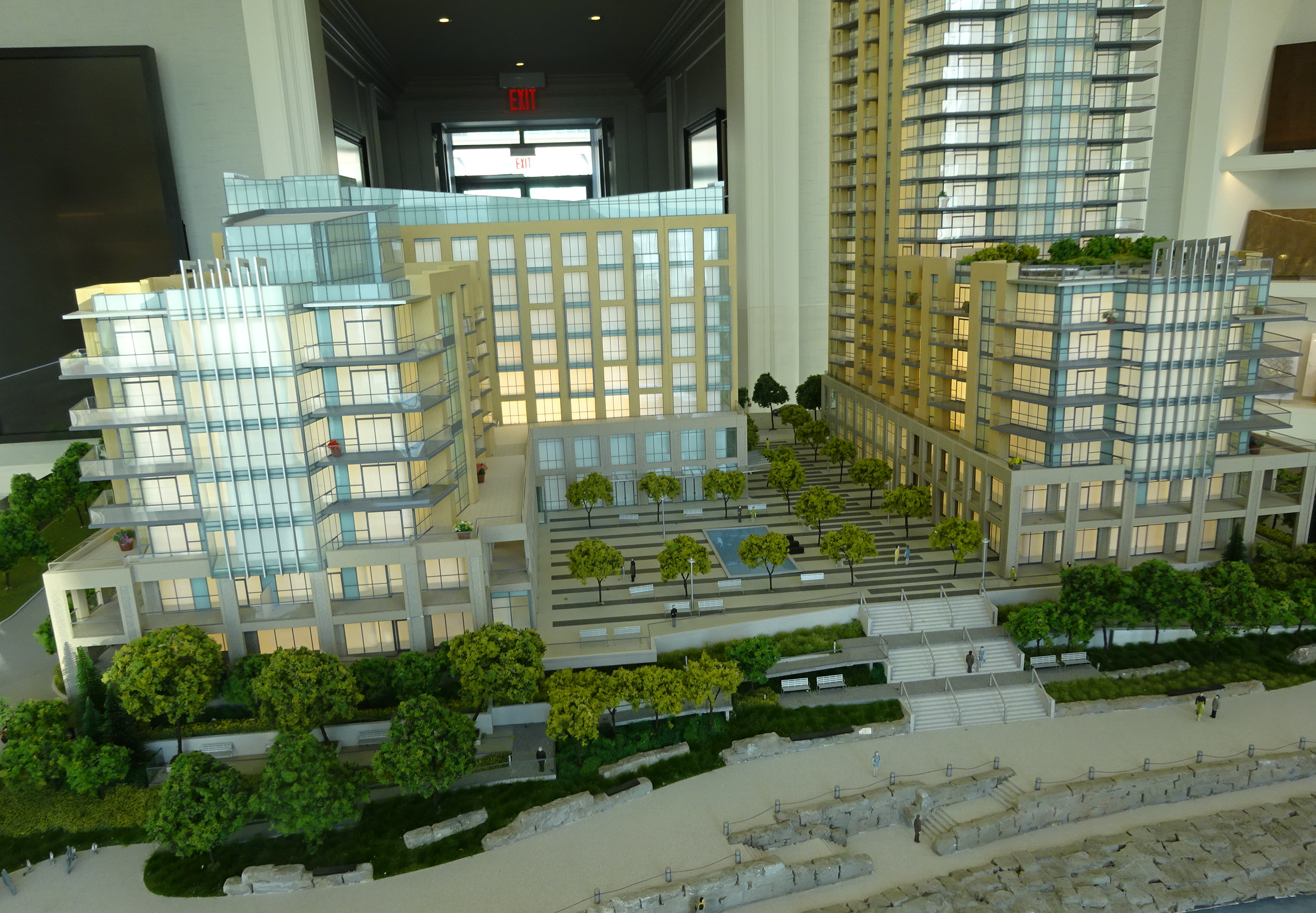 There are several ramps for those who don’t want to manage the stairs and there is a nice winding pathway on the east side – that is already in place. There are several ramps for those who don’t want to manage the stairs and there is a nice winding pathway on the east side – that is already in place.
What the public has not seen is the layout and design of the court yard outside the rear of the hotel and between the two condominiums – one on the east – 22 storeys and one on the west – 7 storey’s.
Set out below are several views of the model. There is a reasonably sized reflecting pool in the courtyard area. Paikin said it was something the city wanted – he didn’t seem to have much enthusiasm for the thing.
It isn’t clear yet how much of the court yard space is going to be fully public and how much will be allocated to the hotel for what will be a lovely outdoor cafe – if such a things is included in the court yard. The hotel, which was originally going to be a Delta Hotel got upgraded to a Marriott when the two operations were merged some time ago.
If the stairs at the south end prove to be too daunting there is a lovely winding path down the eastern side of the 22 storey condominium.
At one point there was talk of some of the lower level condominium units opening out onto that walkway.

The winding path down the east side of the Bridgewater development may prove the easier to navigate.
The walkway is in place now – it was part of a property exchange with the city that included the promenade at the south end that continues on into Spencer Smith Park and eventually into the Beachway Park.
People will be able to have a breakfast in the fresh air overlooking the lake and then walk right through to the canal on the western border of the city. We just might be getting close to what Hamilton has in their waterfront. Some sculpture will be needed at some point.to the
Contrary to rumours being floated around, Jeff Paikin did not buy half of the top floor of the 22 storey condominium; he has a unit in the 7 storey condominium on the west side of the site.

 By Pepper Parr By Pepper Parr
September 11, 2015
BURLINGTON, ON
The city’s Development and Infrastructure Standing Committee won’t be holding a day time session this time around – there doesn’t appear to be all that much happening on the development side of things – is that good news? Because there are all kinds of projects in the works.
The agenda for the Standing Committee meeting, which takes place t 6:30 pm on the 14th is as follows:
On the Consent Agenda there are the following:
Report recommending approval of a variance to the Sign By-law to permit a fascia sign at 3365 Fairview Street.
Report recommending dissolution of the Flood Disaster Relief Committee.
 The city doesn’t want the public feeding these critters – staff report has some recommendations – will the public go along with them On the Regular Agenda there is the one item:
Report recommending options regarding the feasibility of a by-law prohibiting the feeding of wildlife.
That issue will draw some views that see this problem quite differently – it is a problem that needs serious consideration. Councillor Dennis and Burlington’s MPP Eleanor have weighed in on this one
There are then two Public Meetings. These meetings are required when the city wants to make changes to its Official Plan – the public is given a clear opportunity to express their views.
There is a report on the city-initiated housekeeping amendments to Zoning By-law 2020. This is not easy reading and for the most part it doesn’t matter – until you have an issue with city and they tell you that there was a change in the bylaws way back when – didn’t you know about it? Lawyers will get you through that kind of mess.
Statutory public meeting and information report for a proposed Official Plan Amendment for 4880 Valera Road.
And that is about it for this first cycle of city council Standing Committee meetings.
There are some concerns with the rather weak agenda.
Has the city manager figured out what it is he wants to do now that he has warmed the chair he sits in for five full months?
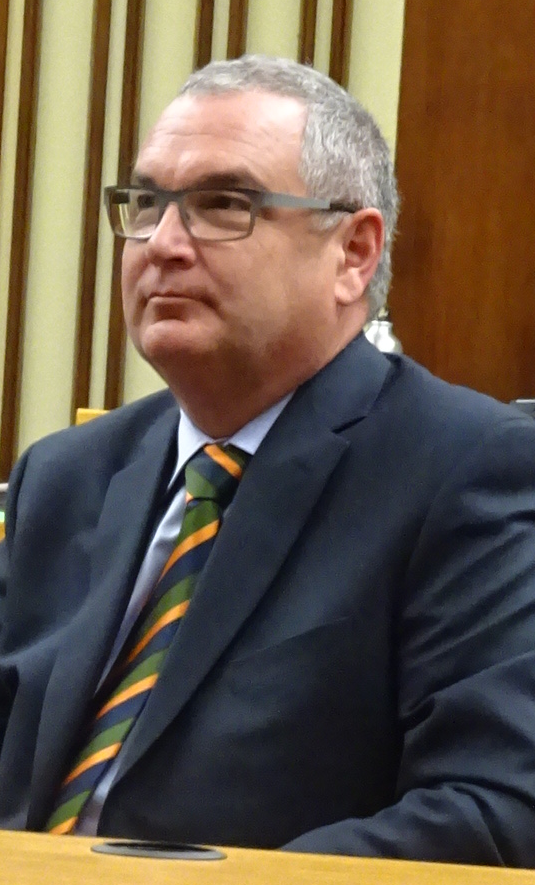 James Ridge – the current city manager has yet to give any sense as to the way he plans to run the city. He brings a much different and an as yet understood style to the job. James Ridge has a management style that is considerably different than his two predecessors. Both Jeff Fielding and Pat Moyle served as city managers with a style that was open and transparent for media.
James Ridge doesn’t see his job in the same way making difficult to understand how he [plans to communicate with the public. He has not made himself available to media; on those occasions when we have been able to ask him questions at the end of a council session he has chosen to be curt with an economy of words that is – how shall we put his – disarming.
Other than that he shipped his pets to Burlington buy air freight rather than drive across the country with them, we know very little about James Ridge. He has yet to make a public comment.
He appears to have decided to join himself to the Mayor at the hip – the administration of the city is distinctly different than the political direction – the politicians come and go – the administration is there forever – ensuring that the doors open every morning and that the streets are cleared of snow and leaves and that the parks are in the shape the taxpayers expect.
There is a respectful distance required between the office of the Mayor and the office of the city manager.
Usually a city manager sets out a work plan and explains to city council in a public setting what and how he expects to perform his duties. This city council has yet to see such a document.
We do know that the production of a Code of Conduct for city council has been punted to the city manager who is expected to somehow fit this into the Strategic Plan that is languishing between various dates on the calendars that determine when Councillors can meet.
The next reported date for a Strategic Plan meeting is October 19th – the public should not expect to get a chance to comment on whatever comes out of the political process before the end of the year – at which time this council will have completed one quarter of their term of office.
The Strategic Plan is expected to inform the review of the Official Plan which is having its own problems getting out of the gate.
People within city hall consistently talk about Burlington’s vibrancy – if there is any such thing in this city it has yet to find its way to the 6th floor where the James Fridge rules the roost.

 By Pepper Parr By Pepper Parr
September 11, 2015
BURLINGTON, ON
The Community and Corporate Standing Committee will meet on Tuesday September 15th at 1:00 pm in the afternoon and again at 6:30 if required.
Standing committees have a procedure they follow. There is a Consent Agenda which consists of Reports of a routine nature, which are not expected to require discussion and/or debate. Any council member can ask that an item be pulled from the Consent agenda for discussion – if not they are all passed in one vote.
For the Community and Corporate Standing committee the following are on the September 15th consent agenda:
Report recommending approval of Burlington Inclusivity Advisory Committee 2015 work plan and providing the 2014 annual report.
Report providing the City of Burlington’s financial status as at June 30, 2015.
Report providing information regarding insurance litigation as of July 31, 2015.
Report recommending approval of a Municipal Capital Facility Exemption for the Aldershot Library By-Law.
Report providing information regarding the operating budget performance as at June 30th.
From time to time a standing Committee considers Confidential Matters which are usually Human Resources issues or property sale and or acquisition issues.
Confidential reports may require a closed meeting in accordance with the Municipal Act, 2001. Meeting attendees may be required to leave during the discussion.
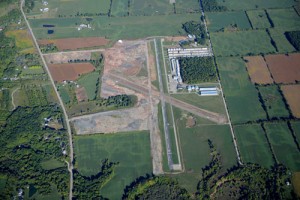 Air Park matter is before the city again – to be discussed as a confidential legal matter this time – something is up. The list this time around is extensive:
Confidential legal department report providing an update regarding the Ontario Municipal Board hearing for 374 Martha Street.
Confidential legal department report providing an update regarding Burlington Airpark.
Confidential legal department report providing quarterly litigation update from May 1 to July 31, 2015.
Confidential finance department report providing the status of the reserve for contingencies as of July 31, 2015.
Confidential appendices A and B of finance department report providing information regarding insurance litigation as at July 31, 2015.
Confidential memorandum from Councillor Craven’s office regarding proposed acquisition of land by the municipality.
Confidential and consent matters make up the bulk of the agenda – all there is left is a Report providing the state of the downtown report and recommending approval of core commitment performance measures.
 The ADI application to put up a 28 storey structure is now before the OMB – city has some information they want to talk about behind closed doors – why? The one item on the agenda that isn’t either a consent matter or a confidential matter is a report providing the state of the downtown which recommends approval of the core committeemen performance measures.
This could be a short meeting for the public. The gazette will provide background on several of the confidential matters

 By Pepper Parr By Pepper Parr
September 8, 2015
BURLINGTON, ON
Once the “love in” part of the evening was over – those in the room at the Royal Botanical Gardens were able to take part in a good discussion on what the province was planning on doing about transit in the province.
 Minister of Housing and Municipal Affairs is in the thick of transit issues as well – Ted McMeekin takes part in Town Hall on Transit Burlington MPP Eleanor McMahon and Minister of Housing and Municipal Affairs MPP Ted McMeekin hosted the event at which Minister of Transportation Steve Del Luca did most of the talking and the listening.
The stopover in Burlington was the fourth Town Hall type meeting Del Luca has held – 40-50 people in the room – close to a quarter of them bureaucrats of one flavour or another.
He told the audience that his mandate was to “catch up” and “keep up” on transit matters. While highways are a large part of that mandate – this meeting was about transit.
Difficult for a Burlington audience not to want to drift into highways when the QEW and the 403 cut us into pieces.
Del Luca pointed out that the government has committed $130 billion over ten years into getting a transit system that meets the needs – it’s amazing how these people throw around those big number – billions – millions.
An additional $31.5 million has been has been added to put a 15 minute – both ways service in place on the Lakeshore, Kitchener, Stouffville and Barrie services.
De Luca made a strong point when he explained the situation on the Barrie line: four trains leaving Barrie every morning and four leaving Union Station for the trip home each evening.
Which was Ok for people who just commute and stay in the city all day but for those who want to slip into the city for an early afternoon meeting and then head back to an office in Barrie the current service doesn’t work – those people explained Del Luca drive in and out – adding to traffic congestion and wasting a lot of time behind the wheel of a car.
The Transportation Minister added that getting 15 minute service has some hurdles to be gotten over – and the electrification of the system has its own problems.
Track ownership is also a problem – but Del Luca was able to leave the impression that he has a strong team and that they can learn to understand the problems and then find solutions.
What was refreshing was that Del Luca didn’t even try to sugar coat the problem.
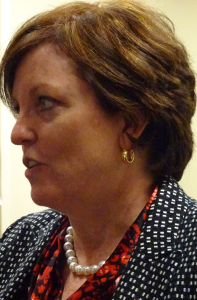 Burlington MPP Eleanor McMahon hosts a Town Hall on Transit and lets the Ministers do all the talking. He made it clear that he wants to see the changes made within a decade and that to make it happen there has to be a change in the culture – the car isn’t going to be what it has been – both in the way it is used and in the way it is designed for the future.
The rail lines are going to be electrified – if we don’t do that greenhouse gasses will kill us all.
Everyone wants better service but the changes we need to make to provide that service will be disruptive – which boots the ball into the political realm. Del Luca’s trip to Burlington was to get a sense of what the public in this part of the world was thinking.
Something not usually seen at Burlington based event s was the participation of students from McMaster. All males and all appeared to be graduate level students – and they had good questions.
Del Luca, who represents Vaughan in the Legislature, pointed out that his mandate is focused on capital projects – this guy is building a transit system – all the bells and whistles on what happens when the transit system is in place is the responsibility of the municipalities that connect with those rail lines.
The only thing the Ministry does, explained Del Luca, is give the municipalities a portion of the gas tax it collects. Burlington got between $20 and $21 million last year.
There are Buringtonians who come close to swallowing their tongues when they see some of that tax rebate being put into infrastructure (roads) upgrades and upkeep.
The cultural change the Minister is working to bring about hasn’t penetrated as deeply as it is going to have to in Burlington – the city may be one of the last to fully understand what has to be done.
There were people from Burlington transit and transportation in the room – but they didn’t seem to be paying a lot of attention from where I was sitting.
There was a little bit of money for new ideas and pilot projects explained Del Luca. “We put $1 million into a fund for new ideas and doled it out in $100,000 grants. It was so popular and useful that we increased the annual allotment to $2 million.”
Milton got a grant to create an application that would let commuters use their smart phones to tap into their transit schedule – there was no mention of any application from Burlington Transit.
 Minister of Transportation for the province Steve Del Luca engages Greg Woodruff on the role of the car in future transit plans – both agree the car isn’t going away. Aldershot activist Greg Woodruff engaged the Minister on the role cars would play in transportation. He pointed out that the car is undergoing a very radical change and added that research suggests there will be 40% fewer cars on the road within the decade – what does that do to your transit plans he asked.
Del Luca told Woodruff he didn’t think he was wrong and added that within the decade 70% of the cars on the rod will be automated. Both men agreed that the car was not going to go away and it doesn’t need to go away – it will just play a much different role and will not dominate the way it has for the past number of decades
While transit was the focus of the meeting – land planning policies that make sense was a critical clutch point – and the sense in the room seemed to be that we weren’t doing all that well on developing those policies.
 Ted McMeekin, a political activist who got into government to make changes talks with Rishia Burke, a staffer with Community Development Halton – an organization McMeekin got started with others many years ago. One could almost see the torch being passed. Minister McMeekin, who wasn’t saying all that much, explained that he was coordinating a review of the urban sprawl we have to work with and what part urban boundaries play in transit planning.
There are transit advocates in Burlington who wonder why the Oakville, Milton, Burlington and eventually Halton Hills transit services are not rolled into a single service – York Region has done that very successfully.
At some point there is going to be transit service along Dundas and rolling up into Milton – whose court will that ball be in – Milton or Burlington?
Creating a smoother transition for transit users in the east end of the city who want to or have to use both Oakville and Burlington transit is another problem
When Burlington’s politicians got all hairy about transit and began taking the bus to work, and making sure there was a photo op to prove they had actually ridden the bus, ward 2 councillor Marianne Meed Ward took the bus to a Regional meeting – that isn’t something she will be doing again.
It has become clear to the government that in order for transit use to be increased – growth and intensification has to be along transit lines.
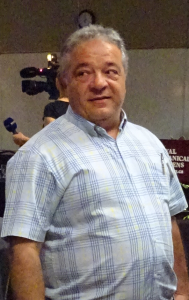 Vito Tolone, interim director of transportation for Burlington, did a lot of listening as the two provincial minsters did all the talking. Their comments seemed to tie into the Draft Transportation Master Plan Tolone is working on Where are the transit corridors going to be in Burlington. Vito Tolone, interim Director of Transportation, is working on a Transportation Master Plan – a draft was put together by people from both planning and transportation. While far from complete – there were some pretty solid suggestions as to the direction the city could consider taking.
Unfortunately there wasn’t much in the way of enthusiasm in the response from city council on what was a well presented set of suggestions and ideas – whatever Burlington does – transit is going to have to be the core – and this city council just doesn’t have much of an appetite for more busses on the streets – all they can see is empty busses going by.
Minister Del Luca asked the municipalities to “work with us and get it right” He wants to do away with the artificial transit barriers and the artificial municipal barriers to get it right.
It is not going to be easy to do that with the city council Burlington has today.
The last topic to get some time was the HOT lanes that were put in place for the Pan Am Games. It may not be popular, but High Occupancy Toll lanes are becoming the flavour of the month in transit and transportation circles.
Ontario transportation officials are fine-tuning a plan to introduce the concept to selected highways in the Greater Toronto Area. Most Ontarians are familiar with HOV (or High Occupancy Vehicle) lanes that require a vehicle to have at least one passenger.
The HOT lane expands upon that, extending access to lone motorists — but charging them a toll. The government is moving ahead on installing high occupancy toll lanes. These are on the way but “we want to make sure we get it right,” he told the media.
At the Burlington event Del Luca said the move wasn’t intended to produce revenue but to free up capacity – the thinking being that if someone was prepared to pay a fee to drive in a HOT lane that meant their car would not be taking up space in the free lanes.
Del Luca told the Burlington meeting that the government had not clearly communicated what the program was, how it would work and the difference it would make.
He certainly got that part right. Many wonder just what the cost would be – and how much would be spent on creating the things – whenever government and technologically are in the same room – the costs just seem to rise – remember the mess and the expense with making hospital records electronic – gazillions – and it isn’t done yet.

 By Staff By Staff
September 4, 2015
BURLINGTON, ON
The City of Burlington is reopening Waterdown Road between Plains Road and Masonry Court on Friday, Sept. 4 between 4 and 5 p.m.
This section of the road had been closed since May 2015 for reconstruction. Working with the city and Halton Region, the contractor installed the new storm sewer, new water mains and reconstructed the roadway, widening the road by one lane northbound and one lane southbound and adding bike lanes in both directions.
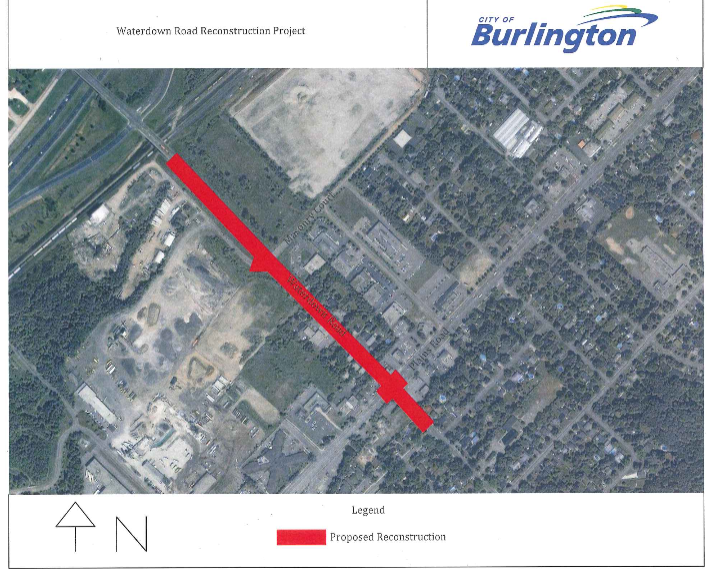 The work done to upgrade Waterdown road south of Hwy 403 got done in pretty short order. It has to be seen as part of the growth that will take place in Aldershot in the near future which will include significant population increases – might call for a ward boundary change as well. Waterdown Road carries 20,000 vehicles a day. The city wants to thank motorists and nearby residents and business owners for their patience during the temporary closure.
The reconstruction project is scheduled to finish in June 2016
The reconstruction of Waterdown Road followed the opening up of the access ramps to highway 403 and sets up Aldershot for a level of development that is important to the city but unwelcome by a number of Aldershot residents.
 The expropriation of all the variety store property, which wasn’t necessary, did open up the land to the east of Waterdown on the north side of Plains Road – a stretch that includes the adult entertainment operation that many would like to see leave the community. The expropriation of the Murphy’s Variety property at the Plans Road – Waterdown intersection was necessary for the road to be widened – taking all the property when the findings of an WOD said it wasn’t all necessary was brutal – showed municipal government at its worst.
The ADI Development Group plans for a large two phase development that was to include apartments and stacked townhouses is somewhere within the planning department – it isn’t clear if the application has been withdrawn or if the city is still negotiating with ADI
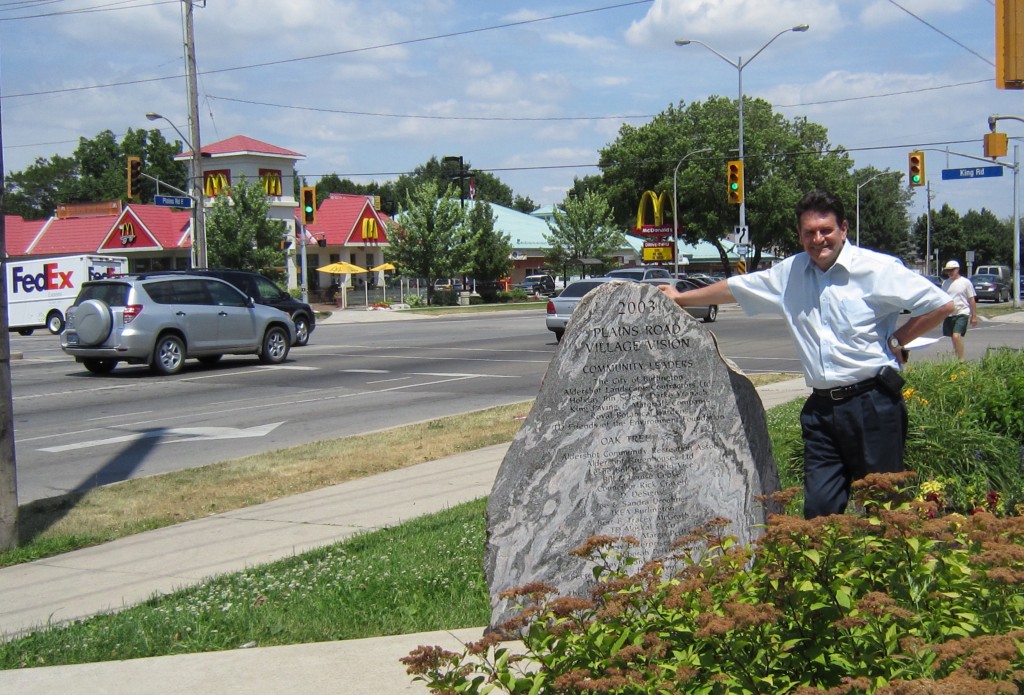 He loves his Ward, he knows his constituents and their needs. He has to be given credit for shepherding the significant amount of development that has taken place. Does the Council member have a larger vision for Aldershot? The proximity of the Aldershot GO station made this part of the city ripe for development. The King Paving property on the west side of Waterdown is surely getting a close look by developers who can put that land to better use and help Burlington meet the intensification targets the province has given the Region
This development takes place at the same time the city gets closer to selecting a new planner to replace Bruce Krushelnicki who retired several months ago.
The re-opening of Waterdown Road and the construction of the King Road grade separation suggest that Aldershot is primed for major growth – which might even include sidewalks on those streets that don’t have them.

 By Pepper Parr By Pepper Parr
September 3, 2015
BURLINGTON, ON
If you thought you had heard the end of the battle over what is going to happen to the 29 homes in the Beachway Park – think again.
The Regional announced that they have now managed to purchase four homes in the Beachway:
1011 Lakeshore Road which they bought close to a year ago, I09 Willow Avenue, 115 Willow Avenue which were estate sales and 1019 Lakeshore Road which was sold in April.
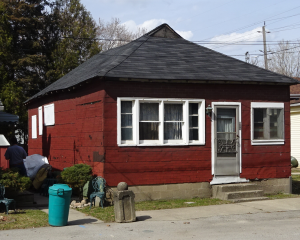 Sold to the Region as part of estate sale; this unit was barely habitable. Nevertheless a princely price was paid for the house. The two Willow residences were part of an estate sale; one of the houses was close to being uninhabitable.
The 1019 Lakeshore Road residence was owned by Burlington lawyer Katherine Henshell who was a candidate for the ward 1 seat in the last election. She fought a tough battle and managed to ruffle the feathers of the incumbent, Rick Craven, when she suggested his property be turned into a bird sanctuary. Craven nevertheless prevailed and remains the ward 1 council member.
Henshell said she arrived at the decision to sell after talking to Anne McIlroy, the planner who was retained by the Region to put together a draft design for a park which was shown to the public at a meeting last April.
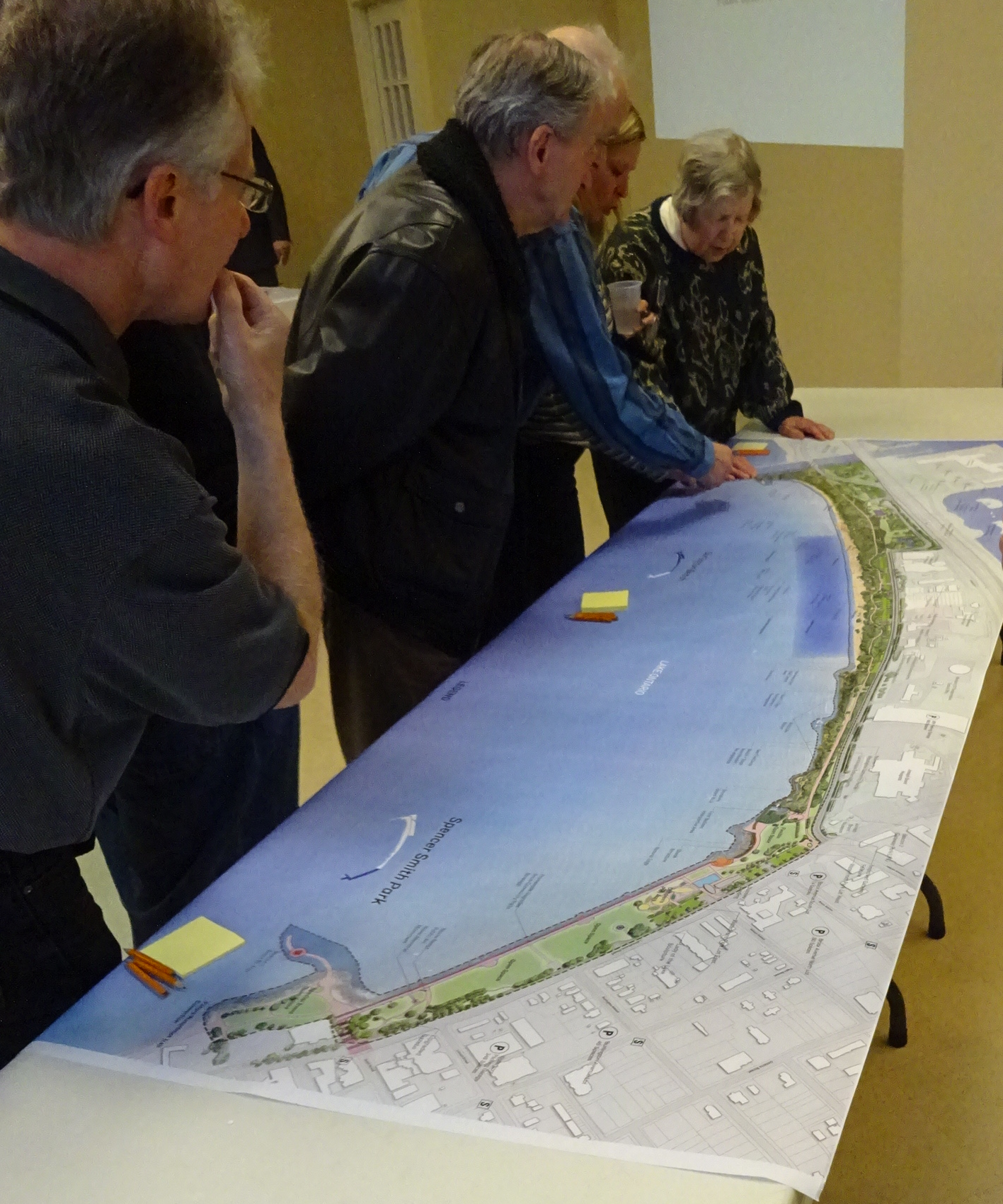 The public got its first look at what the Region had planned for the |Beachway – it was to be a public park with no homes in it. It was a long range plan – 20 years plus and was going to cost $51 million Henshell says she talked with McIlroy, and asked if her instructions were to produce a plan with the homes in place and to produce another plan without the homes in place.
 Planner Anne McIlroy who has done a lot of work for the city of Burlington as well as the Region was retained by the Region to design a park for the Beachway. Henshell says she was told that the instructions the planner was given were to produce just the one design. Henshell said she decided then that there was no point in holding out and that she didn’t think there was much hope.
Henshell had her law offices at the location but moved those office to the downtown core and was renting the property.
She apparently felt that now was a good time to take whatever price the Region was offering. She declined to say what that price was – but did say it was registered on title. The Gazette dug out that those numbers. Wow!
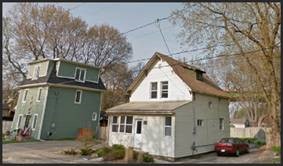 The Henshell property is on the right. The property to the right was bought by the Region last year and was rented back to the sellers for a two year period. Property transfer closed on August 12, 2015. Purchase price appears to be $550,000.00; the documents do not say if this figure includes all the other incentives; legal costs, moving costs, and a disturbance allowance which the Region has said in the past it would provide. The Region’s appraisal report has not been made available.
The Henshell property was transferred from her name to a numbered company early 2015.
The net gain to Henshell over four years was $240,000, that’s a 65% increase over a four year period, which is well over the market price increase trend.
All these numbers are part of the public record.
The property sold for $90,000 in 1995
It sold next for $110,000 in 1999
Sold next for $310,000 in 2011 – Henshell was the buyer.
Sold next to a numbered company that Henshell is believed to have owned and the sold to the Region for $550,000.
Who ever said property was not the best possible investment in Burlington?
Assuming no significant improvements were made to the house, and if you use a 10% price increase year over year, that would bring the property up to about $450,000 from July 2011 when she bought it, to August 2015 when she sold to the Region.
It would be easy to conclude that the Region paid an extra $100,000 just to shut her up. Henshell appears to have done well on this transaction.
The Henshell lot is only 2,400sf, whereas the lot next door (1011 Lakeshore) is just over 8,000sf.
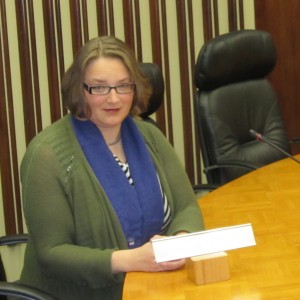 This was as close as Katherine Henshell got to representing the ward 1 seat she ran for in 2014. Hensehll adds that she felt the instructions to produce just the one plan – one with no homes in place – came from the city. Nothing to that effect was ever said at any Burlington municipal meeting. Her view was that if the city was not going to do anything to support the concept of homes in the park then it was wise to take the price being offered and get the equity out.
The Region is arguing that all sales are made on a willing seller/willing buyer basis. The Region is cerainly a willing buyer with a cheque book that seems to have no limits.
The sellers have no one else to turn to – no one is going to buy the property knowing that the Region is going to hound them into selling by offering great prices.
While the willing buyer/willing seller case it put out – there isn’t a person in the Beachway who doesn’t believe the Region will expropriate when they get down to the last few homes – but that is 20 years away.
In May of this year Halton Regional Council approved the Burlington Beach Regional Park Master Plan which would turn the park into a signature waterfront destination, while preserving and protecting its rich and sensitive natural environment.
In a recent statement the Region said: “Implementation of the plan has begun and Regional staff is committed to ensuring you are kept informed about our progress on the work happening in your area. This letter is to inform you that as of October 1, 2015, Halton Region will commence the decommissioning and demolition work to remove all structures located on the following properties in Burlington: 109 Willow Avenue, 115 Willow Avenue and 1019 Lakeshore Road
Halton anticipates these works to be complete by December 31, 2015. As part of the demolition works, the site will undergo environmental remediation work to ensure that the properties are suitable for future park use. The environmental work includes: excavation of any contaminated soils and/or septic systems, filling and
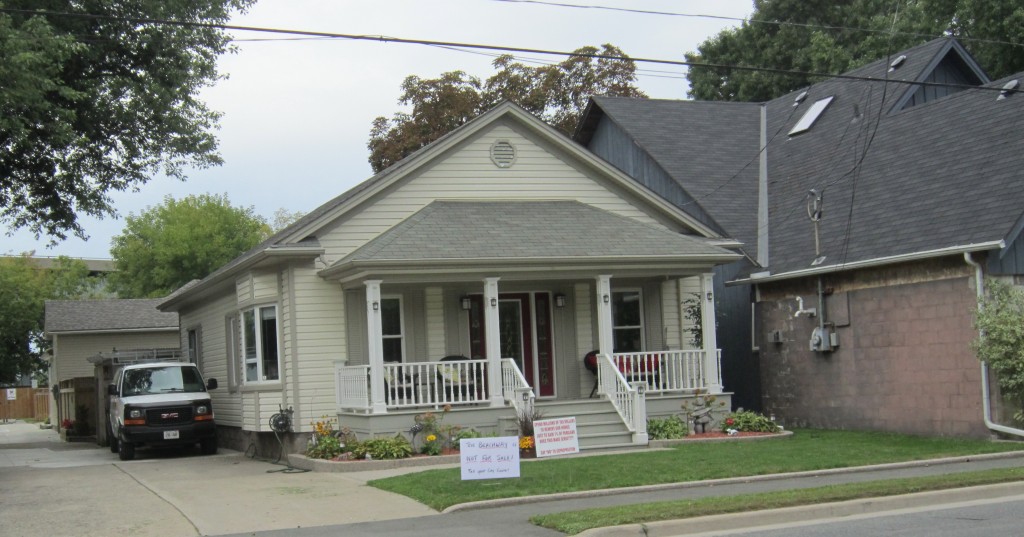 An attractive, well maintained home in the Beachway – the owners struggle to ensure they will be able to remain in their home. The Region is said to have offered $750,00 for this property which has a smaller unit at the rear of the lot. grading of the site (if necessary), and surface plantings to inhibit soil erosion and control surface drainage. This work will be complete during normal business hours to minimize disruption. The Region advised people in the community that all materials left on site from this work will be disposed of. “If you, or someone you know, are presently storing materials at these locations, we ask you to remove them at your earliest convenience.”
Full disclosure: The Gazette has retained Katherine Henshell to represent the company as defendants in the libel case with the Burlington air park.

By P epper Parr epper Parr
August 27, 2015
BURLINGTON, ON
The don’t give up – they’ve got a cheque book that is pretty thick and they can spend; and right now the Regional Realty Services department is wanting to spend taxpayers money to acquire as much Beachway Park money as they can.
To put all this in context – there are 28 private homes in the Beachway Park that the Regional government would like to buy – and they want to do that buying on a willing seller – willing buyer basis. The problem with that is there is really only one willing buyer and not that many willing sellers – but that hasn’t stopped the Region from making offers.
 An attractive, well maintained home in the Beachway – the owner struggles to ensure that it will be eventually expropriated by the Regional government who need it if they are to build an announced park. Helene Skinner, who has been a Beachway Park resident since 2000, told the Gazette that the Region made us an offer back in the spring of $750,000. We said “NO WAY” The location, property and lovely completely renovated homes with all the upgrades is perfect for us !!
Keenan G. Lane, Manager of Realty Services for the Region, said in his letter to Ms Skinner: “On our end, all the reports we have received to date indicate Halton’s offers are certainly in keeping with the larger market.
“It is regrettable that our discussions regarding the Region’s proposed acquisition of your property ended so abruptly. Melissa and I were looking forward to a follow-up meeting with you, wherein we had planned to discuss the additional options outlined in the Burlington Beach acquisition program.
“There are several incentives we are offering all Beach owners, including a 5% purchase premium in recognition of the inconvenience related to relocation. This, together with the fact that you don’t pay commissions to Halton (market rate is 5% payable by the vendor), would mean that you are realizing a 10% premium relative to a private sale at the same number.
“We completely understand your position in this matter, but I hope that you will consider Halton if you do decide to sell your property.”
Skinner replied:
 This Beachway home was sold to the Region for more than $600,000 with additional incentives that included closing costs and the right to rent the house for a number of years. “As indicated by you on behalf of Halton Region, the multifaceted park plan, if approved will start and stop and/or work around the existing homes.”
Skinner uses every opportunity she gets to quote and remind the Region that they would like to buy her property; her concern and fear is that they will expropriate.
Skinner believes it is important for the public and real estate appraisers / agents to be assured that the Beachway community is NOT obligated to sell and/or sell to Halton Region/City of Burlington and that any park enhancements will be made to include the homes as they remain. Again…NO expropriation, hence, our homes can increase in value like all other communities on the open market. The fact that the Region would love to have our property is a value add. Little supply…BIG demand!!!!
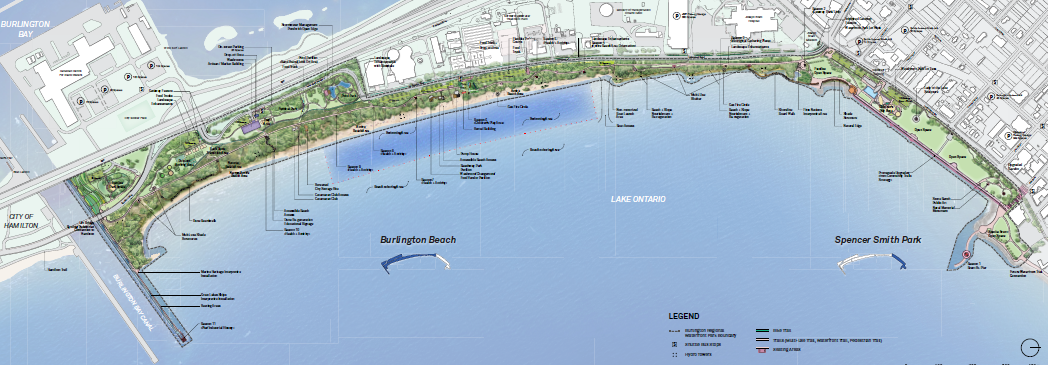 The Regional government released the plans for an impressive park design that would require the removal of the 28private homes in the park. Most residents have no interest in moving – the park design doesn’t allow for the homes. The Region revealed a very extensive Beachway Park re-development plan – that was impressive. One homeowner took exception to the plans and said in a public meeting that while it was a nice plan – “you seem to want to build it on my property and I don’t want you to do that.”
The Region will do what government does – the Beachway home owners will do that they have been doing for more than fifty years – hang tight and stand up for their rights.
Links to related stories:
Beachway Park plans made public

 By Pepper Parr By Pepper Parr
August 25, 2015
BURLINGTON, ON
They will be back soon – that magnificent seven that get paid $100,000 + each year for serving as your representative on both city and regional council.
They have been away from the horseshoe at city hall since the middle of July – and except for the Association of Municipalities of Ontario that was held in Niagara Falls – they haven’t had much to do in the way of formal meetings.
Burlington tends to be very quiet at city hall during the summer. The non-union staff at city hall are not that young.
The five year age range of the 129 people who hold leadership positions
2% are 26 to 30 – 3 people
1% are between 31 and 35
9% are between 36 and 40 – 12 people
16% are between 41 and 45 – 21 people
19% are between 46 and 50 – 25 people
32% are between 51 and 55 – 41 people
13% are between 56 and 60 – 17 people
7% are between 61 and 65 – 9 people.
There is a lot of vacation time to be used up.
 City hall leadership briefs the Mayor on an issue during the budget preparation process The other interesting thing is that close to 50% of the leadership will retire within 10 years; something the Human Resources department spends a lot of time thinking about. The pension plan in place for the municipal sector is seen as very good and many choose to retire in the second half of their fifties and try and new career.
As the members of Council drift back into the city and begin looking at their agendas and gearing up for the fall session – which for them begin September when they do two days of meetings at Regional Council where they will look at the Transportation Service 2014 Progress Report; do an On-Site Visit to Verify Potential Threats to Halton Regional Municipal Water Supply; consider changes to Waste Collection Area Boundaries and a look at the Conservation Authorities Act which is being reviewed.
When Council adjourned in July for the summer break there was no holding of hands and singing Cumbia. The period of time from when all seven members were re-elected last October to the July break was as fractious as this reporter has seen – even in the days when Cam Jackson was Mayor.
Differences of opinion are part of serving the public but the nastiness with which these people treat each other is shameful. On December 18th this Council treated John Taylor, a member of Council with 26 years of experience, terribly. Earlier in that December 18th meeting Taylor was given an long term service award – within a few hours he was basically stripped of committee memberships that he not only deserved but that were dear to his heart.
A few weeks later he came close to having to beg for financial support for Community Development Halton which they needed to cover them until a grant application was approved.
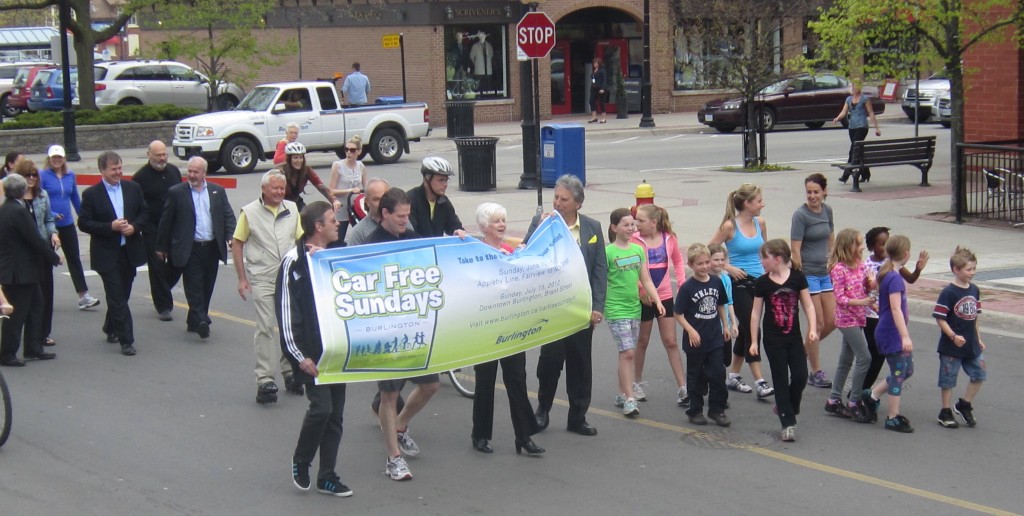 Car Free Sunday started as an event to convince people to get out of their cars and walk, bike or use public transit – it became a party put on at public expense for ward Councillors to entertain their constituents – at $10,000 a pop. Earlier in the session members of Council approved the spending of $10,000 for Car Free Sundays for both wards four and five and ward six. Mayor Goldring commented at the time that the events looked more like politicking than they did occasions when the public got to learn why everyone needed to make less use of their cars. His Worship was right – the events have become political boondoggles; hopefully they won’t be in the 2015 budget.
Councillor Marianne Meed Ward is concerned with the way reports get to Council members and she wondered aloud if two much of the meeting management was in the hands of the Clerk’s Office when it perhaps should be in the hands of the members of Council.
Meed Ward wants to see more “quickly to action” on the part of this council. We are collecting a lot of data but we don’t seem to be getting all that much done. Our growth hinges on creating jobs in this city. While the city does not actually create the jobs is can create the environment and ensure that the services needed are in place.
That means a city hall bureaucracy that serves the needs of people doing business in the city and with the city. We hear of those situations where things don’t work – the complaints, like gossip make the rounds quickly. The good news tends to take a little longer – but there is some good news.
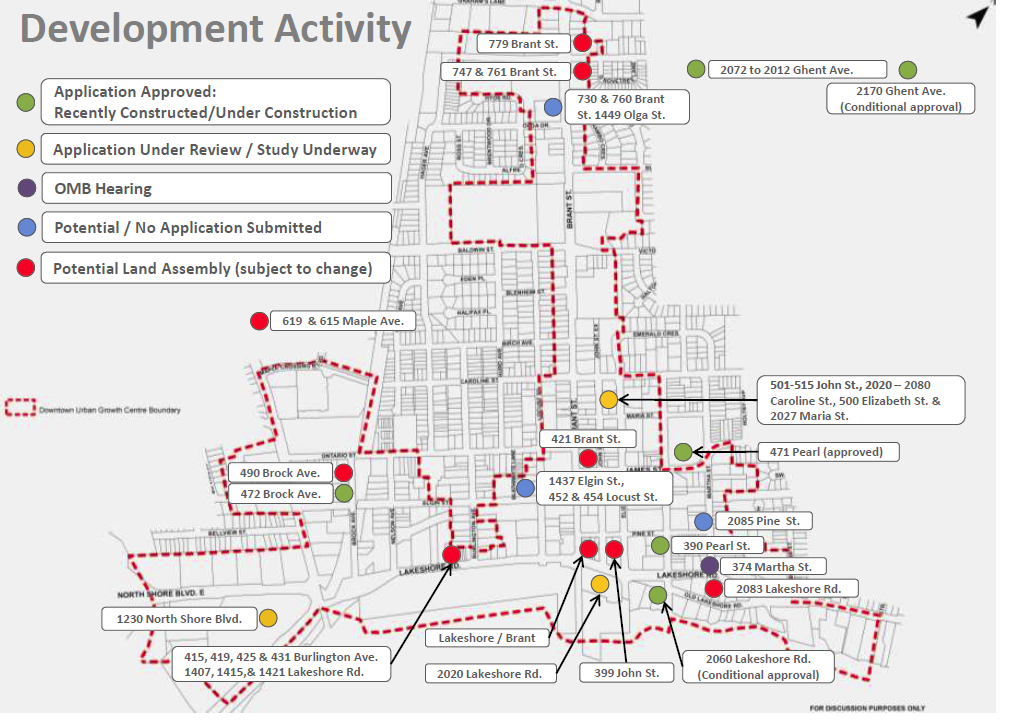 The public got to see information that was not secret but seldom had they had an opportunity to see a lot of data put before them and then be able to discuss some ideas with developers. A number of months ago Meed Ward held several workshops to which she invited the public and those developers who were prepared to sit down and talk specifics about a project they were developing. Meed Ward will complete her write up, pull together all the data and put it in a format that is uiseful to the public. There will be a final public meeting and then everything gets passed on to planning staff who may issue a report on what they heard. staff played a large part in the public meetings – they were as interested as Meed Ward was in what the developers had to say and what the public wanted built in their city.
On balance they were a very worthwhile effort. The final report, which Meed Ward hopes has an impact on the Official Plan Review.
Meed Ward is concerned about the Ontario Municipal Board hearing on the ADI Group development that has been unveiled for the bottom of Martha at Lakeshore Road. Many feel the proposed structure just doesn’t fit and the staff report the city put out made that point quite clearly.
Unfortunately, city council never got to the point where they were able to vote on the staff report which makes whatever case the city has just that much weaker.
ADI filed their appeal to the OMB on the 180th day after they had submitted their proposal. Everyone knew what ADI was going to do – that is the way they do business and what they did was perfectly legal. It is situations like this that bother Meed Ward and many people in the city.
Council she argues is not in charge – we are following – not leading. For Meed Ward the Martha – Lakeshore Road development is a game changer. Meed Ward puts it this way: “There is something wrong with our issues management process” and she wants to see changes made. “We are handcuffed with the current process” she said.
 Standing up and being counted – Councillor Meed Ward has asked for more recorded votes than any other member of Council. Knowing what your elected member is doing for you is an essential part of the democratic process. City council meets next on the 14th of September.

 By Pepper Parr By Pepper Parr
August 18, 2015
BURLINGTON, ON
Part two of a two part feature on the development potential for the city
Way back in 1985 council approved the building of what was then referred to as a legacy building that would soar 22 storeys into the sky. One wonders if Niagara Falls could be seen from the top floor.
It took several decades to get the project to the point where all the regulatory hurdles were overcome. There still isn’t a shovel in the ground but there is a sales office and the look of the project is out there for all to see.
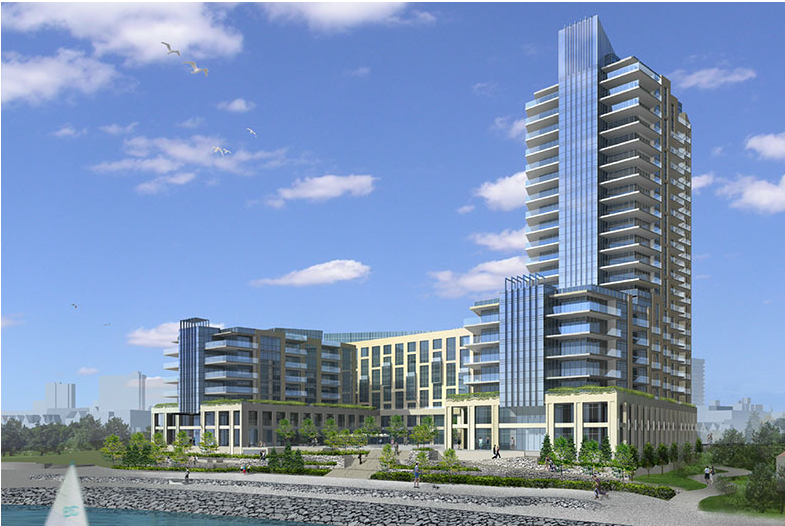 Architectural rendering of the Bridgewater development that will consist of two condominiums, owe 22 storeys and the other seven storeys and an eight storey hotel. The view is from the lake looking west. It will be a three structure development that will change the look and tone of the downtown core more than anything has since Joseph Brant had his house built on the edge of the lake.
Immediately to the west of the development there are plans to re-develop the Waterfront hotel and replace what is there now with a possible three structures.
The arrangement in place was to have the city come up with two plans and the developer come up with a plan of his own.
If the projected plan for the Waterfront hotel site is done properly Burlington will have a cluster of hotel locations all within a city block of each other sitting on the edge of the Lake with the pier as a place for people coming to conventions to stroll along. Spencer Smith Park will be laid out before people in the hotel; some of the early thinking had the new hotel that would be built opening to the west.
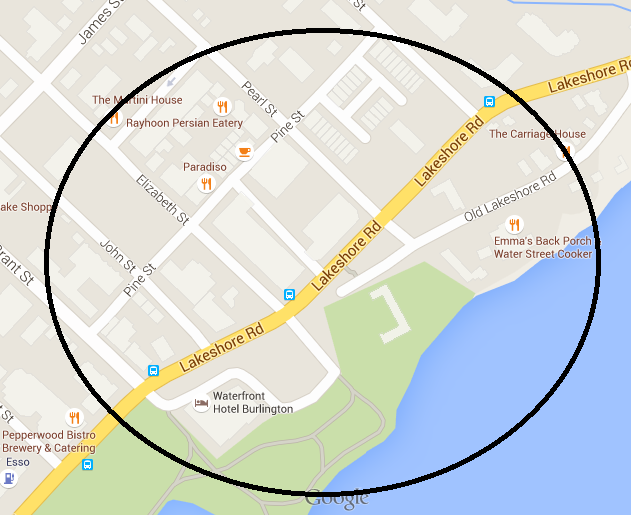 The potential that two quality hotels in the downtown core is hard to fully grasp – but it is there. When? One of the sites was first approved in 1985. Different players may manage to get some wiggle into the process. There is tremendous opportunity for everyone here; Burlington needs a downtown core that will attract people, give people a reason to come to the city and take in an event at the Performing Arts Centre and tour the world class ceramics collection.
The Bridgewater development – that is the two condominiums and the seven story hotel – is now in the hands of a quality developer. Jeff Paikin has done some fine work in the past and while this development is quite a bit larger than anything he has done in the past in Burlington – he has the executive capacity and the vision to make this happen. He also has a sincere desire to make his hometown a better place.
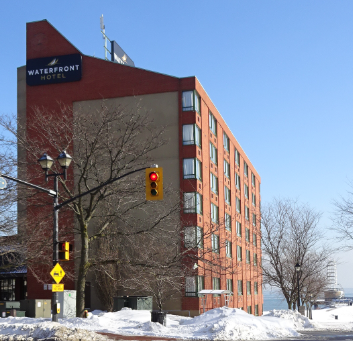 Think in terms of the Waterfront Hotel being torn down and the site having three buildings using up some of the space to the rear of the hotel.  The ADI Group development for Lakeshore and |Martha now has a name. They are running advertising in local media and are in the process of turning a retail location on Brant Street into a sales office. They are very serious. The problem development for many is the ADI Group plans for a 28 story tower at the intersection of Martha and Lakeshore Road which has been named the Nautica. The development is now before the Ontario Municipal Board; Burlington hasn’t done all that well at OMB hearings and ADI have brought in a top notch Bay street law firm.
The fly in the ointment for project that are not at the OMB is the pace at which things happen in Burlington – everything just seems to take forever – and we get passed by. The continuity needed to ensure real progress takes place hasn’t existed at city hall. Burlington has been through two city managers with the third just getting the feel of the city.
If you add in the short period of time Pat Moyle was brought in to oversee things while General Manager Scott Stewart basically ran the city – the total is four city managers in five years. They seem to stay for just over two years and then move on. One of the four was shown the door.
Good municipal people tend to leave the city and look for a location that has more in the way of top level management that provides a setting where they can grow their own careers.
There are some exceptionally good people who do fine work on your behalf day in and day out.
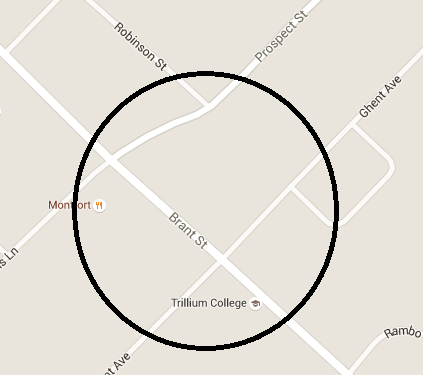 If the developments that are well beyond the thinking stage do it right this art of the city could become a new destination which a charm of its own – at least one of the developers just has to do it right and change some of their out of date thinking. A second very good development cluster is coming together on Brant Street at Ghent.
The Burlington Square Plaza has announced their plans to significantly upgrade the site and add four levels of residential with commercial at grade level.
That site has not managed to attract the commercial tenants it wanted. A new real estate firm has been brought in to rent the space and attract the kind of clientele that can take advantage of everything the site offers. The patio potential for the location is superb.
A block north at the Prospect intersection with Brant there will eventually be a development that puts a high rise in place – expect the application to be for more than the eight storeys the Official plan allows.
There is an opportunity for the developers of that site to retain some of the city’s heritage by including at least a portion of the GET NAME and date in any development.
A shift in thinking about how to work with the member of council who represents the ward would serve everyone much better.
There is still an element within the development community that feels council is there to hold up projects – the planning department is in place to ensure that the rules are fair and that the public interest is protected.
Land is not there to be exploited by the owners; land is there to be used to the benefit of everyone – not just the owners who are entitled to the best return they can get. Good projects have consistently given a higher return to bot the owners of the land and the community they are located in.
It is time for developers to think more about the city that is being developed rather than just the financial return. There is more than ample evidence showing that quality always pays off – anything less than the best that can be done diminishes everyone.
 Robert Molinaro works with citizens on some ideas for the property they have assembled at Brant and Ghent The Molinaro Group has assembled properties on either side of Ghent across the Street from the Burlington Square Plaza. The opportunity for a cluster of buildings that will create a destination further up Brant Street offers another opportunity that we should not let get away from us.
At least one of the Molinaro brothers has taken part in the working group sessions Councillor Meed Ward held recently. Her final report on what came out of those sessions is due late in September – it will be interesting to see what comes out of those public participation events
The opportunity on Lakeshore Road with the planned development s that will put more high end residential development into the downtown core and create a cluster of hotel capacity is only good news.
The city will need to upgrade its Tourism department to handle what will become a very different city that needs a more sophisticated approach to promoting the city. With two hotels within a block of each other and a Performing Arts Centre a short short walk away and a patio with several good restaurants looking over the lake – the city will be ready for small conventions.
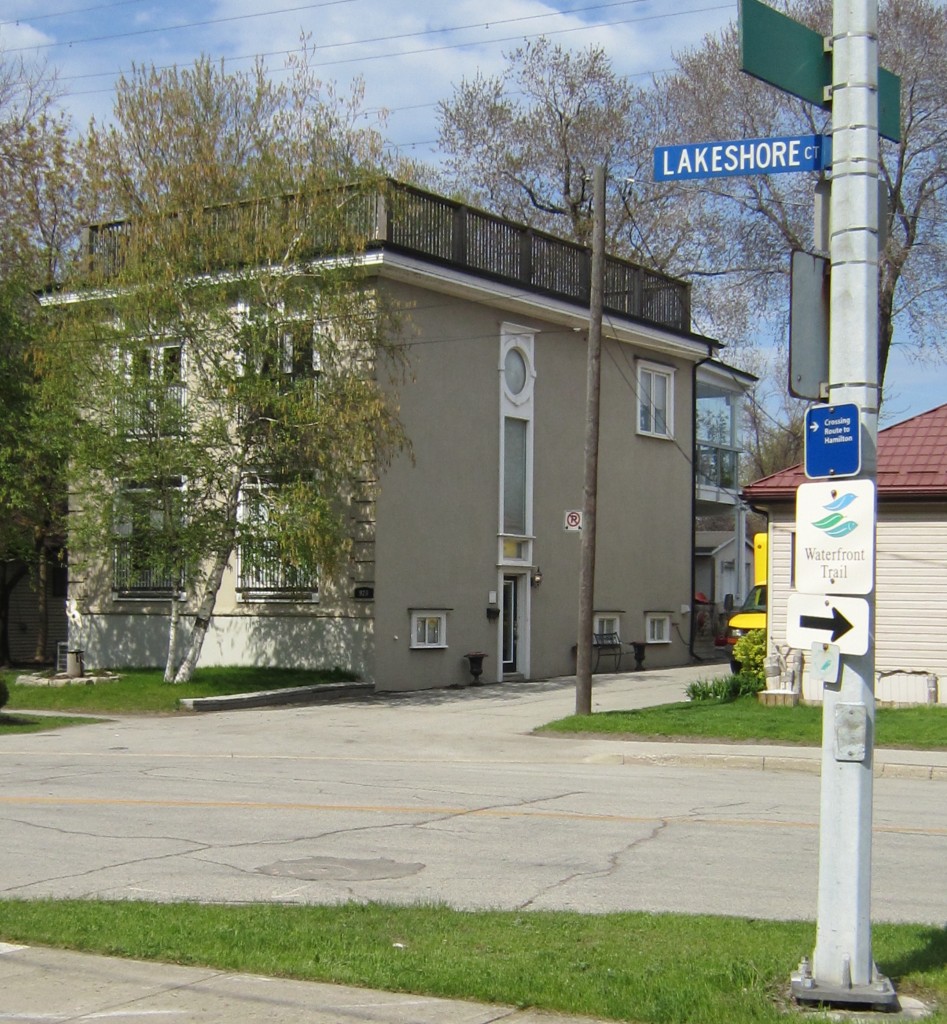 Residents on the Beachway have spent thousands of dollars to upgrade their properties – this is where they live and where they want to stay. One of the better examples of improved properties is this house on Lakeshore Road. It would serve as an important part of a community park if it were retained. Mixed in with all this is the long range plan to turn the Beachway Park into something that will rival anything elsewhere in this province – indeed in the country.
If a way can be found to keep at least some of the residential component in the park we will have shown the world that we understand the importance of community – which translates to having people who serves as the eyes on the street.
If one were to stand back and look at the potential – one could get a little giddy with excitement – all we have to do is make it work. The vision is already there – executing on that vision is what the current council needs to do.
Links to related articles in the Gazette.
Ward 2 Councillor convinces the developers to take part in her workshops.
Part one of this feature.

 By Pepper Parr By Pepper Parr
August 18, 2015
BURLINGTON, ON
Part one of a two part feature on the development potential for the city
Each city council, at the beginning of its term, meets for a number of weeks and hammers out a Strategic Plan.
That Plan sets out what the city council wants to get done during the four years they are going to serve the citizens.
There is very little in previous Strategic Plans worth remembering, except for the plan approved in 2011. For the most part they were a collection of pictures and motherhood statements.
I had the opportunity to look at six or seven previous Strategic Plans – something I doubt the majority of the current Council bothered to do. Councillors Taylor and Dennison were at the table when those documents were approved.
The Strategic Plan approved by the previous council, which was made up of the same people we have in place now, was a very impressive departure from anything done before.
Both Council and staff worked very hard – sometimes at cross purposes – to produce a document that served the city well. There were some very moving occasions when we got to hear how Councillors felt about the city they were leading.
In the closing session Councillor Jack Dennison spoke very emotionally about the need to ensure that the downtown core was given the attention and the resources needed to grow and become a large part of the focus for Burlington.
We also got to see some of the character traits from some of the Council members that were disturbing then and disruptive now.
The city was fortunate to have an excellent facilitator who not only led the group but educated several of them on what works and the way Strategic Plan development gets done.
Perhaps hoping to build on what was achieved the last time around Council set out to craft the Strategic Plan for this term of office. It is not going very well.
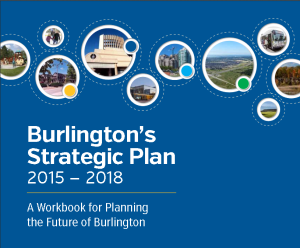 It may well be 2016 before the Strategic Plan is approved. will it be as good as what this Council did in 2011? The city hired KPMG to direct them in the creation of the Strategic Plan for the current term but did not manage to get the same facilitator.
There is now a team in place that is going to do tonnes of research and bring back a large handful of options. Unfortunately,
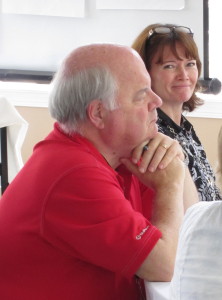 Georgina Black did a superb job of getting a new city council through the creation of a significantly different Strategic Plan. Councillor John Taylor loved every minute of it. Burlington wasn’t able to get Georgina Black back – she was the facilitator who did such fine work with council in 2011. Much of the work that KPMG is going to do was already being done by Frank McKeown, the Executive Director of the Economic Development Corporation. McKeon wasn’t able to attend the meeting at which all the research work KPMG is going to do was discussed.
McKeown explains that he wasn’t told of the meeting until two days before it took place and that he was already committed to be elsewhere.
McKeown adds that he had not seen the agenda. When it was brought to his attention – I think we heard him gulp. McKeown will resolve that problem and will have the needed discussions with KPMG.
The creation of the 2014 – 2018 Strategic Plan is not off to a very good start. Council will not meet on this matter until the second half of October. They will have been in office for a year by that time
There are going to be some very sticky Governance issues that do not look as if a reasonable resolution is going to be found. Despite the comments made regularly by Mayor Goldring – his is a very fractious council that is deeply divided on some critical issues.
The amount of time, attention and financial resources to be given to community based initiatives will be limited by budget constraints due in no small measure by the cost of the 2014 flood.
Some exceptional work has been done within the cultural sphere – the city now has two new people running major cultural institutions. Robert Steven is running the Art Gallery of Burlington and Susan Haines will take over the running of the Performing Arts Centre in September. Hopefully the Centre Board has retained retiring Executive Director Brian McCurdy to serve as a consultant for three to six months to oversee the transition.
The Performing Arts Centre had gotten itself to the point where it was finally stable financially and the program being offered was working. Community groups were now a real part of the program offerings. There is every reason to believe that Haines can continue the work McCurdy did and eventually grow her board to the point where she can put her own stamp on the place.
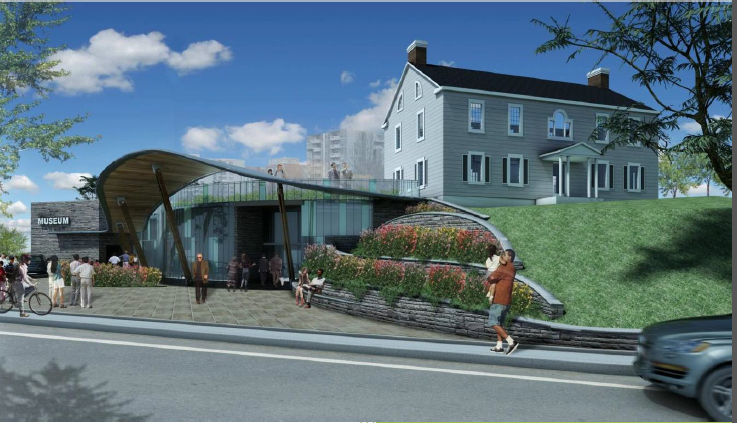 The concept might have merit but there is no way this kind of an installation is going to work on a single lane road that is the main entrance to the hospital once the redevelopment has been done. Lakeshore Road has to be widened for the hospital traffic. The Museums have their work cut out for them but it doesn’t look as if they are going to draw on the city for financial support. There is however, some very hard thinking to be done on just what happens to the Joseph Brant Museum. The plans on the drawing board are just not going to work – someone needs to have the courage within the Museum Board to look at the facts and the changes that are going to take place on Lakeshore Road when the hospital re-development is done.
Ireland House on the other hand is a gem; it offers some exceptionally good programming.
Development: what does the city want and where does it want any development to take place – and what kind of development as well.
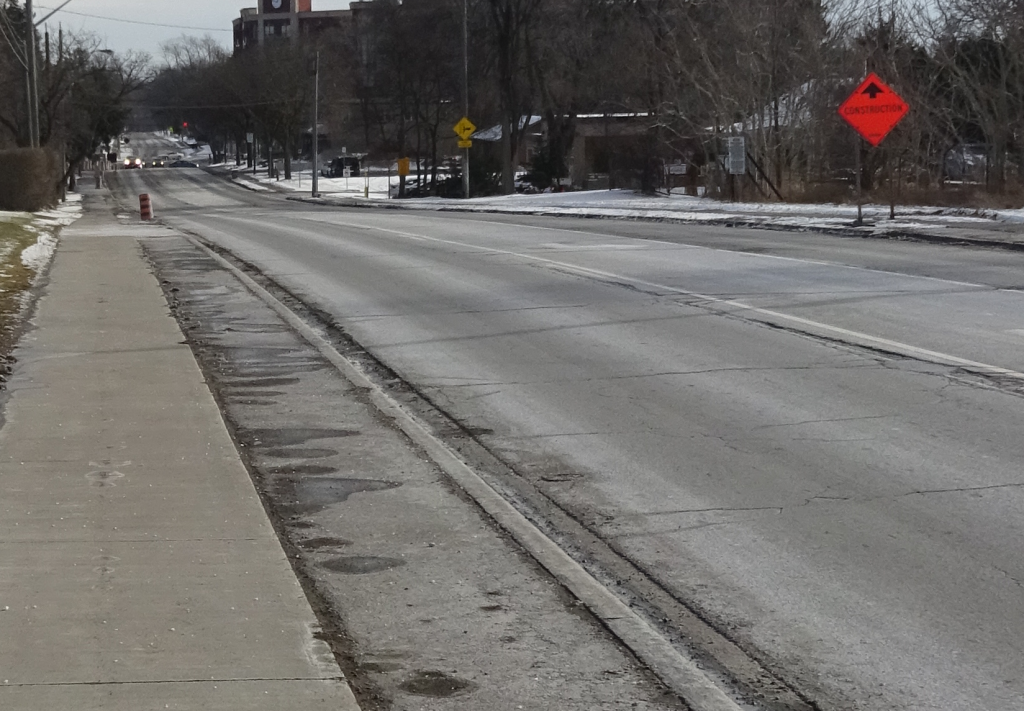 Waterdown Road is being widened – a precursor to some significant development. The Aldershot GO station was named a transportation/development hub – the developers may get their shovels in the ground and have walls up before the city arrives at some decisions. There is all kinds of development taking place in Aldershot – there is some dissension amongst the more active citizens and the council member does need to learn to listen a little better. Understanding who he represents would be a useful contribution Rick Craven could make to the quality of civic government in this city.
Councillor Meed Ward continues with her, unique for Burlington, approach to involving the people she represents.
There are two areas of development that can re-shape the kind of downtown core Burlington is going to have – both are in her ward.
Before going into any detail on those two opportunities – the culture at city hall needs a closer look.
There are departments that work exceptionally well – finance is perhaps the best run shop at city hall. The team if focused and well led. They were given the task of revamping the way budgets were prepared and presented to the public and told to make personal accountability part of the way city hall does business.
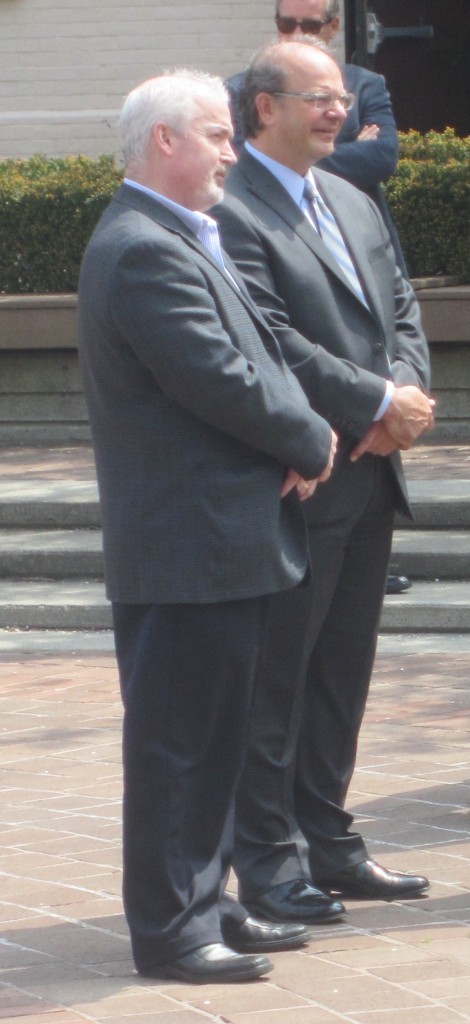 Scott Stewart and former city manager Jeff Fielding – they were quite a tag team for as long as it lasted. Fielding always let you know what was in the works – the new city manager has yet to reveal a management style. Then city manager Jeff Fielding challenged the finance department to bring about the change – then he departed for greener pastures and became the city manager in Calgary to the work that gets done.
The finance department did deliver; unfortunately there isn’t a champion on city council to ensure that the work done is continued and that staff get the direction they need.
A significant cultural change is taking place within the planning department; the hiring process for the new city planner is at the short short list. That decision may have already been made.
This is a critical choice – the department is in the middle of completing a much delayed Official Plan Review; we may not see that document until the end of the year.
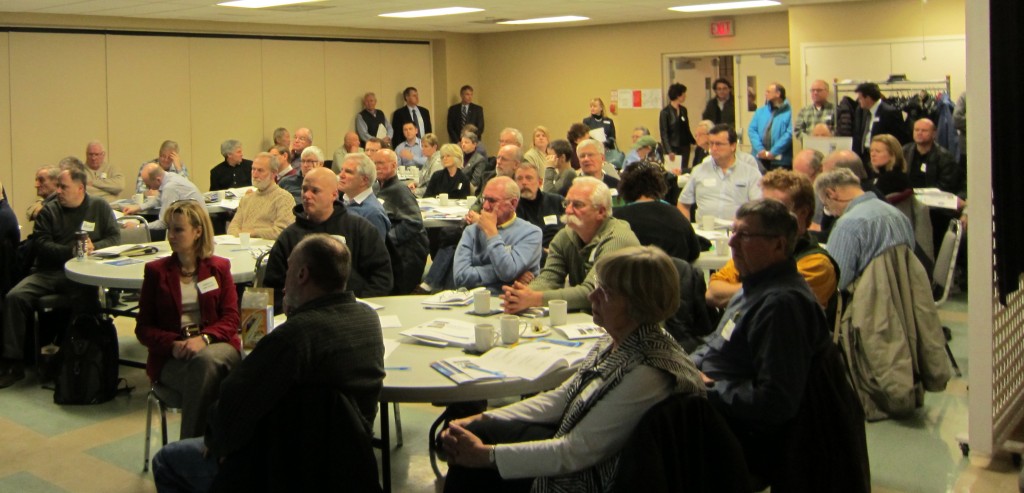 A rapt audience listened to an overview of the 2014 budget. What they have yet to have explained to them is the desperate situation the city will be in ten years from now if something isn’t done in the next few years to figure out how we are going to pay for the maintenance of the roads we have. Add in the cost of the 2014 flood and the city has a whopper of a budget to explain. Public engagement is a sorry mess – few remember the recommendations that came out of the Shape Burlington report that every member of this council heartily endorsed and then forgot about. There are reports of an initiative the city will announce in the fall that is neighbourhood oriented – it will be interesting to see the details.
The current city manager doesn’t seem to have all that much appetite for real public engagement, the communications department is asking the public what they think about City Talk, a magazine format distributed to every household, that does more for the members of city council than anyone else.
Council members love the thing; the communications department spend endless hours making revisions and the public for the most part doesn’t know it exists. There is a savings opportunity there.
Now to the development potential in ward 2.
Part two of a two part feature.

 By Pepper Parr By Pepper Parr
August 5, 2015
BURLINGTON, ON
What would Burlington look like with 100 Strata’s built around the city?
 This is what the Strata looks like. Councillor John Taylor thinks the city is going to need 100 of these in the next 25 years to meet the intensification target set by the province. What’s a Strata? That’s the condominium the Molinaro gropup built on Maple Avenue.
That was the potential ward 3 city Councillor John Taylor tossed on the table during a city council Committee of the whole recently.
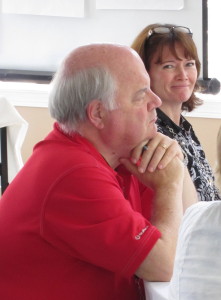 John Taylor, Councillor for ward 3 and the Dean of Burlington’s city council Taylor puts the city’s current population at 175,000 people – the signs as you enter the city say 176,000.
The Growing in Place program – that is a provincial government directive, calls for Burlington to have a population of 195,000 by 2031
That number is thought to rise to 210,000 by 2041. The projection for 2041 number is something that is still being worked out by the Region and the four municipalities in Halton.
We can quibble all we want but the bald fact is that between now and 2041 the city is expected to add 35,000 people to the population total.
And because there is no development north of the Hwy 5 – 407 line – all those people have to be tucked in south of that line
Taylor says his math works like this.
Assume the 35,000 number for 2041 is real – assume two people per unit that means we need 17,500 housing units.
The Strata has 175 units – add two 0’s to that number and you have what is needed
 Are 100 Strata’s really needed to reach the intensification target. Where would they get built> The Strategic Plan and the review of the Official Plan are the documents that will guide and inform these decisions – but they may not see the light of day in their final form until sometime next year. Therefore Taylor points out you are going to need 100 Strata’s to house those 35,000 people.
And that is going to put intolerable pressure on the city’s transportation network.
Those cold hard facts are also why the ADI Development Group bought up the land at Masonry Court in the west end – they will do exceptionally well with that project financially. And they will have little difficulty getting the approvals they need – if city council doesn’t approve the project – off ADI will go to the OMB. That is what they are doing with the 28 storey structure they want to build at Martha and Lakeshore Road.
 The ADI development planned for the corner of Martha and Lakeshore Road will help meet the intensification target – what would it do to traffic and the look and feel of the downtown core if the Ontario Municipal Board approves the project. The city is battling on two fronts – dancing with developers who point out that the housing has to be built and we have just the project for you.
While the transportation people point out that the infrastructure we have in place now cannot handle the traffic those 35,000 people will create.
It’s a tough one, especially for a city council that is one – not united on how to handle this problem and two; a council that has never been transit friendly.
Add to that a city that still doesn’t understand how to communicate with its citizens.
The Mayor is reported to be thinking in terms of a population growth of from 1% to 1.5% population growth. The Mayor hasn’t been available for comment on these number. He has been softening up the public for the intensification that is inevitable.
There is a lot for the public to think about – but before they can think through the issues and arrive at conclusions – they need facts from the city.
Seen any facts from the city on these problems lately?

 By Pepper Parr By Pepper Parr
August 5, 2015
BURLINGTON, ON
When the draft of the Transportation Master Plan was put before city Council, which was meeting as a Committee of the Whole, Councillor Taylor commented that “it was a lot to take in at one sitting – and indeed it was.
The presentation itself took well over an hour with Interim Director of Transportation Vito Tolone working as a tag team with planner Kaylan Edgcumbe.
The gist of it all was that the intensification the city was going to have to undergo to absorb its share of the 1 million additional residents the Region of Halton was going to have to accommodate between now and 2031 meant a level of congestion “Burlington didn’t have much tolerance for”.
In surveys done by the Transportation department there were two almost diametrically opposed sets of comments – one from the over 55 set and another from high school students.
Using the dictum that a picture is worth a thousand words the two graphics below tell very different stories.
 Hundreds of students responded to the questionnaire that asked for comments on modes of transportation. The planners and the transportation experts needed to know how high school students looked at public transit. They knew that the older than 55 set thought – getting them out of their cars was going to require crow bars.
 The Senior set didn’t appear to be ready for much in the way of change. Transportation staff made the observation that “Burlington doesn’t have much tolerance for traffic congestion” Without a change in the use of transit – congestion is about all we have to look forward to. The transportation met with the principal at Charles Beaudoin school and asked if they would participate in a “bike” week program with the city. “The principal wasn’t all that keen on the idea at the beginning” explained Tolone “but he came around and we learned a lot – they also learned what they needed to know, which was that younger people weren’t married to the car to the same degree as their parents.
 Bike to school week at the Charles Beaudoin school saw a very strong uptake on bike use that held after the event. Can it be made an ongoing habit? The week before “bike week” there were 60 students at Beaudoin using their bikes to get to school. During bike week there were 260 using their bikes. After bike week more than 75% of that additional 200 were riding their bikes to school.
 This is the kind of congestion the transportation department wants to see. Tolone saw hope on the horizon. His research tells him that with intensification now an inevitability and no room to build additional road capacity – and no desire on the part of the city to do so either – other ways had to be found to move people around.
Expect to hear a lot of the phrase “complete streets” added to the “modal split” we are already hearing about.
Last week the province introduced that acronym HOT for high occupancy toll lanes – if you want to use those lanes intended for high occupancy vehicles with just one passenger in the car – you pay a toll.
The longer term objective is “behaviour change” we just don’t have the road capacity to handle the traffic that intensification will bring with it.
Councillor Taylor opined that the number of people the Region is going to set as the Burlington target will amount to 100 Stratas – a bit of an exaggeration perhaps but he made his point.
 Councillor John Taylor said there would have to be an additional 100 towers the size of the strata on Maple Avenue – claims he has the data to back that up. Strata is the name given to the Molinaro condominium of Maple Avenue.
The Committee of the Whole meeting was short two of its members – Councillors Dennison and Meed Ward were not present. Meed Ward was recovering from the concision she suffered when her car was rear ended.
At the conclusion of what was a long meeting city general manager Scott Stewart made the comment that “this is a web cast we will be looking at more than once”. Indeed they will because there was no clear sense of direction from the five members of Council in the room.
Transportation and intensification are words that are now linked together and we are going to hear a lot more about both in the years ahead. In order for the needed changes to be made behaviour is going to have to be changed and in Burlington that is no small matter.

 By Pepper Parr By Pepper Parr
July 26, 2015
BURLINGTON, ON
It is difficult to find a developer in the Burlington area who will say great things about the city. It is easy to find developers, particularly the smaller ones, who do not have a complaint they are quite ready to share with you.
The “counter” – that’s the place developers first go to when they want to talk to people in the planning department, is often the focus of the complaints.
Developers will complain that they can never get a straight answer from the planning department and that just when they think they have everything the city needs in the way of reports – they find that yet another report is needed.
The planning department doesn’t see it quite that way – but they didn’t want to talk for attribution.
 Scott Stewart loves that sweater – has he had it since 1967? Scott Stewart, the General Manager for Infrastructure and Development is serving as the Interim Director of Planning – and he is a lot different from the recently retired Director of that department.
Stewart wants to see a culture change within the department and has moved some people around and adds “there are some noses out-of-place” in the department but there will be a change”.
The bringing in of a new director for planning is a Stewart hire to make and he is pretty clear in his mind what the city needs.
James Ridge, city manager, has some planning experience in his background – he and Stewart should be on the same page on this one.
Burlington’s city council members don’t, at times, fully appreciate the command structure at city hall. Council hires the city manager and he runs the city for them. Council creates policy and issues Staff Directions – the city manager follows those directions.
The city manager is there to advise and guide council – but the marching orders come from Council. Decisions get made by city council based on policy and specific votes made by the seven council members.
They don’t do the actual hiring – a source has suggested to the Gazette that the Mayor wanted to be in on the actual interviewing of the short list for the director of planning – that shouldn’t happen.
The story is told, from a sterling source, of the Council member who said he thought Council should be involved in the hiring of everyone down to the Director level. The person who told the story said to the council member: ‘You clearly have no concept of what staff accountability is all about.’ With this Council it is referred to as “getting into the weeds”.
Most municipal governments have well qualified, committed professional staff. They do have a pension that is not available to most people and it might seem as if they get a lot of time off. When senior staff are taking part at public meetings in the evening – are they required to be at their desks first thing the next day? Many people in Burlington think they should.
When the budget is going through its final phases – the team that creates that document, based on instructions from city council, work well into the night frequently to complete the budget.
Whoever the city hires as its next Director of Planning, hopefully will be with the city for several terms of office. The elected officials come and go – in Burlington they don’t seem to go very often which is unhealthy but until the voters in town decide they want different leadership we’ve got what we elected.
There is a bit of a leadership crisis at city hall; there are culture changes that need to be made in several of the departments.
 Scott Stewart on the left,and former city manager Jeff Fielding, put a number of major changes in place – but then Fielding saw a greener pasture and headed west for Calgary. Burlington has had three city managers in five years plus an interim filling the chair until a new city manager was hired.
Every management leader needs time to create the kind of work force and working environment that results in the kind of service delivery the public wants. Some good people have left the city for other jurisdictions because the lack of solid consistent leadership that would allow them to grow as civil servants wasn’t in place.
Burlington now has a city manager who has yet to make his mark. James Ridge isn’t a Jeff Fielding, his predecessor. He is more cautious and quite a bit quieter and appears to be a stickler for the rules. A deal maker he isn’t.
We need another year of observing Ridge to get a clearer sense as to what kind of a staff he wants to have in place to deliver the program he understands the city council wants.
We have watched Ridge admonish this Council ever so slightly when they appeared to be resisting the making of a decision. Ridge will, in his quiet way, hold their feet to the flames.
Ridge is not a big believer in the concept of Master Plans – Burlington has been in love with the things for years.
Ridge thinks they create silos and he seems to want a more homogenous approach to the way staff think through their problems. It is going to take him some time to determine where staff changes have to be made and then implement those changes.
Fielding was exceptional at getting out and talking to people; you always knew when he was in the room. Ridge is a quieter person – we are only beginning to get a sense of his decision making process.
Council has handed him a hot one – the Code of Conduct that has been kicking around for far too long and should have been agreed upon by this Council at its last meeting. Some fancy procedural foot work on the part of Councillor Sharman, aided and abetted by Councillors Craven and Lancaster, to reverse a change that had been agreed upon at Standing Committee preciously resulted in the whole matter being referred to the city manager who would work with it as part of the governance section of the Strategic Plan.
Strategic Plan sessions are frequently, if not always, done off site or in a room at city hall where there is no web casting capacity.
The scallywags on this council like it that way. It’s going to be messy.
Staff observes these changes and turn to their city manager to save them from this kind of unprofessional behaviour.
 James Ridge the day he was introduced to the public at a council meeting – he didn’t say a word. Is Ridge up to the job – can he manage the Mayor and the rest of |Council and hold a draw a clear line or will he choose to become “friendly” with council and fetch water for them rather than pour cold water on silly, expensive ideas that they come up with and expect him to find the money to pay for
James Ridge has the summer to work this one out. How he resolves this will tell what kind of a city manager we have; what kind of a culture will prevail at city and what kind of a city we end up being. This assumes that he completes his five-year contract.

 By Staff By Staff
July 21, 2015
BURLINGTON, ON
The following is as dry as toast.
You have to be a bear for punishment to read through it all.
We have highlighted what we think is really relevant in bold
What you are about to read is the publication of changes the federal government wants to be made applicable to WORDS
The federal government recently released a draft of new rules and regulations that will apply to air parks and aerodromes once the public comment period has ended.
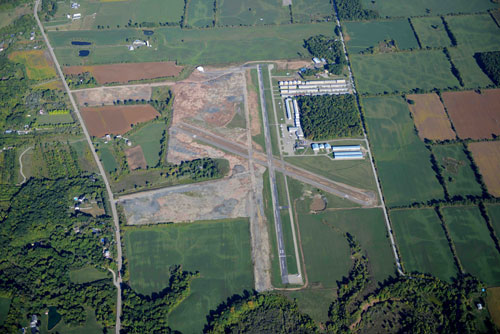 The photograph is dated – the runway cutting across the north south has been upgraded considerably and the land leveled for planned development. No one other than the imagination of Air Park president Vince Rossi knew what the plans were – and they kept changing. These proposed Regulations would address the current identified gap in regulatory requirements by ensuring that there is a consistently applied notification process in advance of aerodrome work. This proposed amendment introduces clarity, predictability and increased communication for all stakeholders. The proposed Regulations are expected to provide an overall benefit to Canadians directly impacted by aerodrome work as the Regulations would compel proponents to engage stakeholders and solicit and mitigate their concerns in advance of construction. Industry will experience greater planning and cost certainty. A consequential benefit is an increase in coordinated land use between proponents and land use authorities.
These new rules will impact the ongoing legal battle between the city and the Burlington Air Park that has been in the court for close to three years.
Operators wishing to develop a new aerodrome or to significantly modify an existing aerodrome, whether it is certified or not, are not currently required to conduct consultations with affected stakeholders. Matters integral to aviation fall under federal jurisdiction, including aerodromes. However, the federal authority, unlike municipal and provincial authorities that have consultation processes in place for significant changes to land use likely to have an impact on the community, does not have a public engagement requirement to identify and mitigate stakeholder concerns in advance of aerodrome development.
The municipal and provincial stakeholders do not necessarily have to be consulted prior to the development of a non-certified aerodrome within their own jurisdiction. As a result, the lack of coordinated development planning can lead, for example, to inefficient land use and increased complaints from local constituents due to the impact of unexpected development.
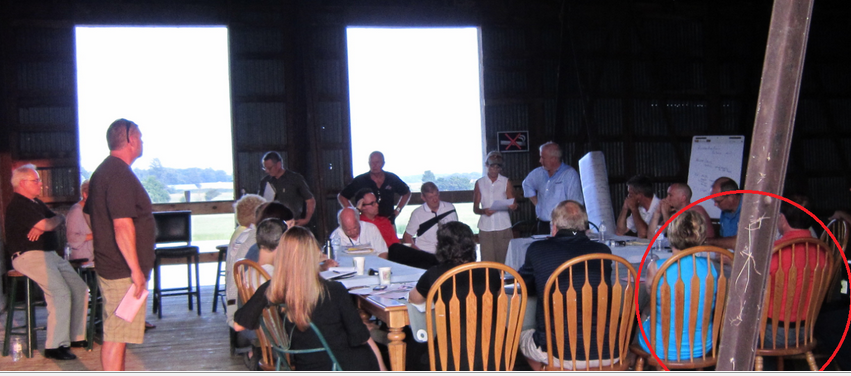 Vince Rossi, in the red sweater on the right sits next to ward 6 Councillor Blair Lancaster at the only community Rossi attended. His comment to the many requests made at the time was that he would “take them under advisement”. Operators and stakeholders seeking aerodrome certification are required to have a consultation process but do not have a federal standard to guide them on what constitutes meaningful consultation. The implications for industry and other stakeholders include inconsistent approaches to consultation, insufficient information shared with affected stakeholders, and costs and delays for proponents or operators who, upon completing what they deem to have been an appropriate level of stakeholder engagement, find themselves caught in legal disputes over the validity of their process instead of commencing with their development.
 Burlington city manager at the time, Jeff Fielding, taking a strip off Glenn Grenier, who was advocating for the Air Park corporation at a city Council meeting. City lawyers stand aside at the right. The Government of Canada has exclusive jurisdiction over aeronautics in Canada and has established a legal framework through the Aeronautics Act (the Act) and the Canadian Aviation Regulations (CARs) that sets out robust safety requirements for the civil aviation industry. There are approximately 2 000 registered aerodromes, of which 547 are certified, and there are an estimated 5 000 unregistered aerodromes.
It is understood and recognized that aerodromes are engines for nearby communities, that they are vital to the growth of a number of Canadian industries, and that the current legislative framework for activities at aerodromes has generally worked well, particularly during the initial growth of aviation in Canada.
What has bothered the economic development thinkers in Burlington is just what does the Burlington Air |Park have planned. Almost everyone has found it very difficult to get any useful information from |Vince Rossi, president of the Air Park corporation.
These factors, coupled with the need for a strong aviation transportation system, illustrate the need for increased communication in advance of aerodrome development to help understand and mitigate public concern, promote Canada’s aviation sector, and satisfy the growing need to keep moving people and goods.
A common concern raised by stakeholders to the Minister is the absence of a regulatory requirement for proponents and operators of aerodromes to notify affected stakeholders prior to aerodrome development, including the establishment of new aerodromes and expansion at existing aerodromes.
In 2014, the federal government amended the Aeronautics Act to provide the Minister of Transport with the authority and necessary tools to effectively respond to an increasing number of aerodrome issues pertaining to development, location, land use and consultation. The amendment also provided the Governor in Council with the authority to make regulations to prohibit the development, expansion or a change to the operation of aerodromes, as well as the authority to require proponents and operators of aerodromes to consult stakeholders prior to the development, expansion or change to an aerodrome or its operations.
The federal government wanted to encourage responsible aerodrome development and operation by requiring proponents and operators to consult affected stakeholders in advance of undertaking aerodrome work through a structured notification process.
 Vince Rossi, president of Burlington Executive Airpark Inc., at a meeting with members of the Rural Burlington Greenbelt Coalition that took place in a barn a couple of hundred yards from the end of his largest runway. To strengthen the consultation process for aerodrome work by providing details within the CARS that will introduce greater clarity and predictability around developments, compel increased communication to identify and mitigate concerns in advance of development, reduce post-construction complaints from affected stakeholders, reduce the chance of delay and costs associated with process-related challenges brought on by affected stakeholders, and allow for better coordination of land use by all interested stakeholders.
The proposed Regulations amending the Canadian Aviation Regulations were born out of the concerns raised by interested parties adversely affected by aerodrome development, by proponents and operators frustrated by costly administrative and legal delays, and by the general aviation community concerned for its future in Canada. The nature of the concerns centre on improved communication in advance of construction between proponents of aerodrome development and those most likely to be affected by the development. Requiring consultation in advance of commencing construction will allow for many concerns to be proactively raised and mitigated.
Residents of ward 6 have been arguing this point from the day they learned of the tonnes of land fill that was being dumped on the air park property. Both the citizens of that ward and the Gazette were very pro-active, a little too proactive for the owners of the Air Park who sued Pepper Parr, Denis Monte and Vanessa Warren along with the corporate parent of the Gazette – that case is winding its way through the judicial process.
The current regulatory requirement to consult is limited to those seeking to certify an aerodrome, and they are only required to consult local land use authorities. The proposed Regulations broaden the requirement to consult by way of notification to include anyone seeking to undertake a prescribed aerodrome work, whether creating a new aerodrome or making a significant change at an existing one, certified or not. The Regulations also provide minimum expectations for how the notification process should be conducted, including timelines, whom to notify and under what circumstances.
The proposed Regulations define aerodrome works that require advance consultation as constructing a new aerodrome and building a new runway at an existing aerodrome. The lengthening of an existing runway has also been included but, in recognition of the differences between small and large aerodromes and so as not to capture all extensions as well as to focus primarily on those likely to lead to an increase in level of service, only extensions in excess of 100 m or 10% of overall length (whichever is greater) will be subject to the proposed Regulations.
To ensure that those most likely to be affected by proposed works receive information about them and have an opportunity to share comments and concerns, proponents and operators of aerodromes will be required to notify interested parties prior to undertaking the prescribed aerodrome work. The proposed Regulations outline a list of interested parties to be notified, which is geographically determined as follows.
In the case of an aerodrome work that is located in or within 4 000 m from a built-up area of a city or town, notice must be given to
the Minister; the local authority responsible for collecting property taxes; and the public within a radius of 4 000 m from a built-up area of a city or town.
This will certainly be good news to property owners on Appleby Line and Bell School Road who have been glamouring for an opportunity to get their comments on the record. The city of Burlington will also take some comfort as well from these proposed changes
 Minister of Transportation Lissa Raitt attended an Air Park social function. Vince Rossi wears a red sweater, second from left. The proposed Regulations prescribe minimum requirements for consultation. Although flexible enough to accommodate the differing complexities of projects that could be undertaken at Canada’s 7 000-plus aerodromes, the minimum requirements are prescriptive enough to introduce certainty for proponents and for stakeholders alike, so that engagement is conducted in a meaningful manner. The proposed Regulations allow all parties to understand under what circumstances consultation is required, what information about the aerodrome work must be shared and the manner in which it is shared, what the opportunities are for affected stakeholders to provide feedback, how concerns are dealt with, and that the Minister will have the responsibility for making decisions on unresolved objections. It is anticipated that, by increasing the amount of information shared in advance of construction, most concerns can be heard and addressed proactively with the goal of mitigating negative impacts to the greatest extent possible.
The proposed Regulations prescribe a minimum of 75 days between the notification and the commencement of the aerodrome work. Transport Canada recognizes that more than 75 days may be required for more complex works and the Regulations allow for additional time to be added as needed. The proponent is required to notify all interested parties by way of a notice and by placing a sign in plain view of the public where the aerodrome work will be undertaken. The notice and the sign must include a drawing and description of the proposed works, the estimated start and completion date, the contact information of the proponent and the deadline for comments to be received (which must be at least 45 days from the initial date of notice).
Within 30 days of the end of the notification period, the proponent will be required to prepare a summary report of the consultation and submit it to the Minister. It must contain a description of the proposed works, the persons who were notified, a summary of the comments and objections received and the proposed actions, and any objections that were not or could not be addressed. The report must also be available to anyone who requests it for a period of at least five years.
Within 30 days of receiving the summary report, the Minister will send the proponent a notice that either provides confirmation that the works may begin or that requests information required by the Minister to be able to evaluate any outstanding objections or measures for the purpose of making a decision. The proponent of the aerodrome work may undertake the aerodrome work at the end of 30 days if there are no outstanding objections or on a date specified by the Minister. The proponent must start the aerodrome work within five years of the submission of the summary report. If more than five years pass, the proponent or operator will be required to undertake a new consultation.
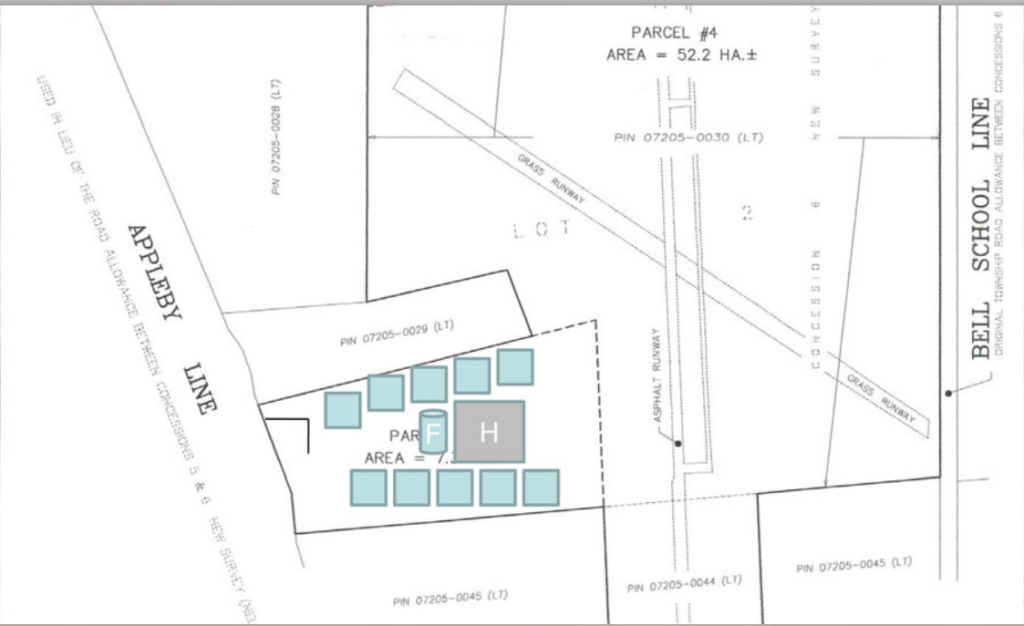 A drawing showing the location of what are believed to be helicopter landing pads less than 25 yards from a residents drive way on Appleby Line. Transport Canada recognizes that there are some circumstances in which these Regulations should not apply. The following exceptions are therefore provided: Heliports and aerodromes primarily used for helicopter operations;
This exception will put the willys into Barbara Sheldon who has property cheek by jowl to the air park; there were plans to located a helicopter facility beside her front yard.
Through its principal means of reaching out to industry — the Canadian Aviation Regulation Advisory Council (CARAC) Web site and by way of email to 525 stakeholders — Transport Canada shared a preliminary assessment document to determine how best to proceed with the creation of the proposed Regulations. Based on the significant feedback received from stakeholders, a focus group was established. The primary purpose of the aerodrome focus group was to discuss the regulatory proposal that would require an aerodrome proponent or operator to notify affected stakeholders prior to undertaking prescribed aerodrome work.
Transport Canada held a number of focus group meetings; June 2014 to have a policy-level discussion on the regulatory proposal and February 15thl.
One of the concerns was about the subjective nature of the wording, including the lack of definition of certain terms, such as “reasonable” and “acceptable.”
The association groups and the municipal governments highlighted an issue with the definition of an “ad hoc aerodrome,” stating that there is no outlined responsibility for tracking the 30-day period, which would cause issues with enforcement. Individual organizational comments are highlighted below.
Municipalities want to be included in the consultation process even if the aerodrome is proposed in a neighbouring non-built up area, i.e. they want the radius to be increased.
They felt the duration of the consultation process was too short; Transport Canada should require land owners adjacent to aerodromes to consult with operators before any new land use activity commences to assess the impact on aviation safety and aerodrome operations.
A second focus group meeting was held at the end of March 2015 to modify the proposed Regulations in response to industry concerns regarding the scope, applicability and prescriptive nature of the requirements. Transport Canada addressed these concerns by clarifying the intention of the proposed Regulations and working with focus group participants to make changes to the scope, applicability and prescriptive nature of the NPA. For example, the kinds of developments or changes at existing aerodromes that would trigger the notification process were defined and the requirement to have a community meeting as part of the process were dropped, since it was felt that the result of sharing information and soliciting feedback could be achieved without it. To address the concerns raised by provincial officials and Canadians relating to aerodrome work in or near protected areas, the requirement to notify nearby federally protected area authorities was added.
The majority of the annual aerodrome work will be undertaken at smaller aerodromes, not at the major international airports. Of the 13 major international airports in Canada, only 3 have planned future development expected to take place over the next 15 years.
For proponents of aerodrome work at smaller certified airports or registered aerodromes outside of 4 000 m of a built up area of a city or town, the c
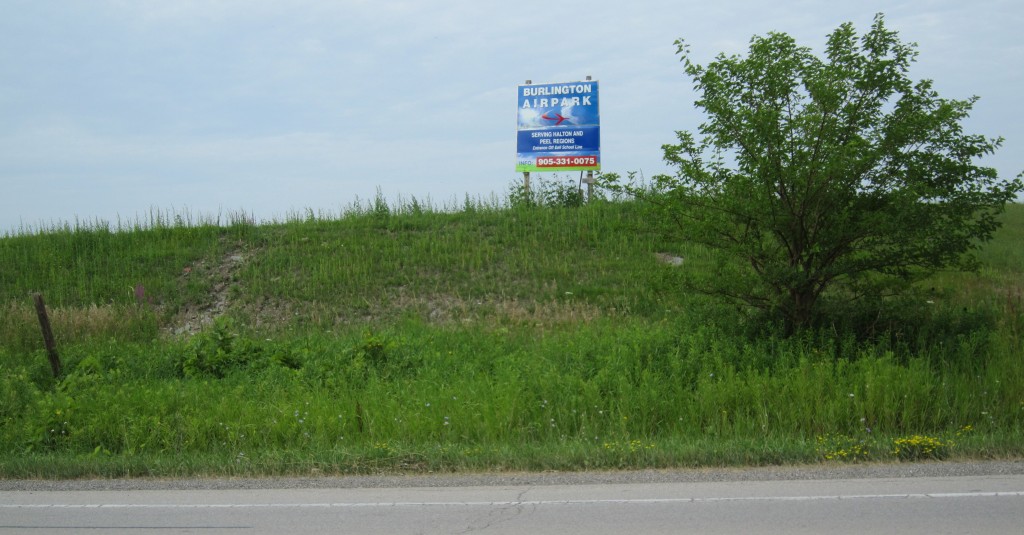 The Air Park has yet to file a site plan with the city of Burlington which would suggest that anything they want to build going forward would have to be discussed with the city and the property owners close to the air park. A sign indicating work was planned would have to be erected on this location, among others. These amendments will be enforced through the assessment of monetary penalties imposed under the Aeronautics Act, which carry a maximum fine of $5,000 for individuals and $25,000 for corporations, through suspension or cancellation of a Canadian aviation document, or through judicial action introduced by way of summary conviction.
Interested persons may make representations with respect to the proposed Regulations to the Minister of Transport within 30 days. The regulations were published July 11 which gives people until August 11th to comment. All representations must be in writing and cite the Canada Gazette, Part I, and the date of publication of this notice and be sent to Marie-Anne Dromaguet, Chief, Regulatory Affairs (AARBH), Civil Aviation, Safety and Security Group, Department of Transport, Place de Ville, Tower C, 330 Sparks Street, Ottawa, Ontario K1A 0N5 (general inquiries – tel.: 613-993-7284 or 1-800-305-2059; fax: 613-990-1198; Internet address: https://www.tc.gc.ca).

 By Staff By Staff
July 15, 2015
BURLINGTON, ON
Which is it?
The one that was approved by the city at a council meeting or the one that is on the sales sign on the property?
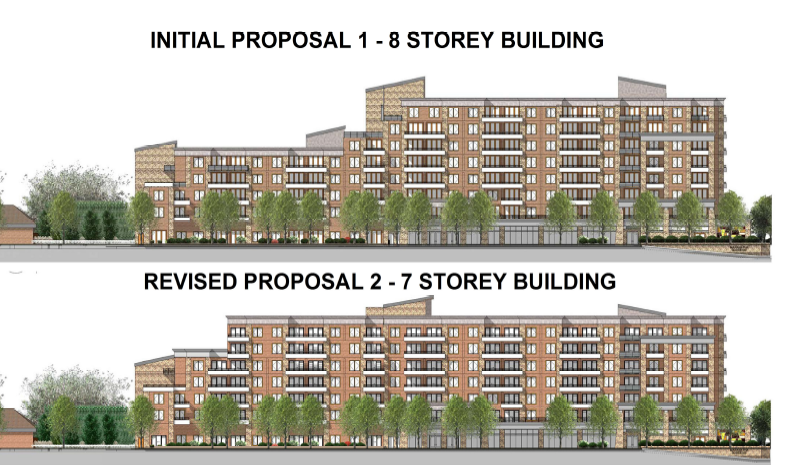 The initial proposal was for an eight story building – that got whittled down to seven. Many felt there was still too much massing. When Maranatha Gardens was first proposed it was a seven story structure that some felt had too much massing.
A lot of jaw boning with the people in the planning department brought about a revision that seemed to keep most people happy. The Mayor said he believed that some of the people who were opposed to the size of the building would eventually live in it – now there’s an endorsement for you.
 With even more jaw boning the project got cut down to six floors with a large open space to cut down on what many thought was a massive wall in a location that wasn’t appropriate A community group took the matter to the OMB – but soon gave that up and for all intents and purposes the project was a go.
The lot has been cleared and there is some kind of a construction schedule.
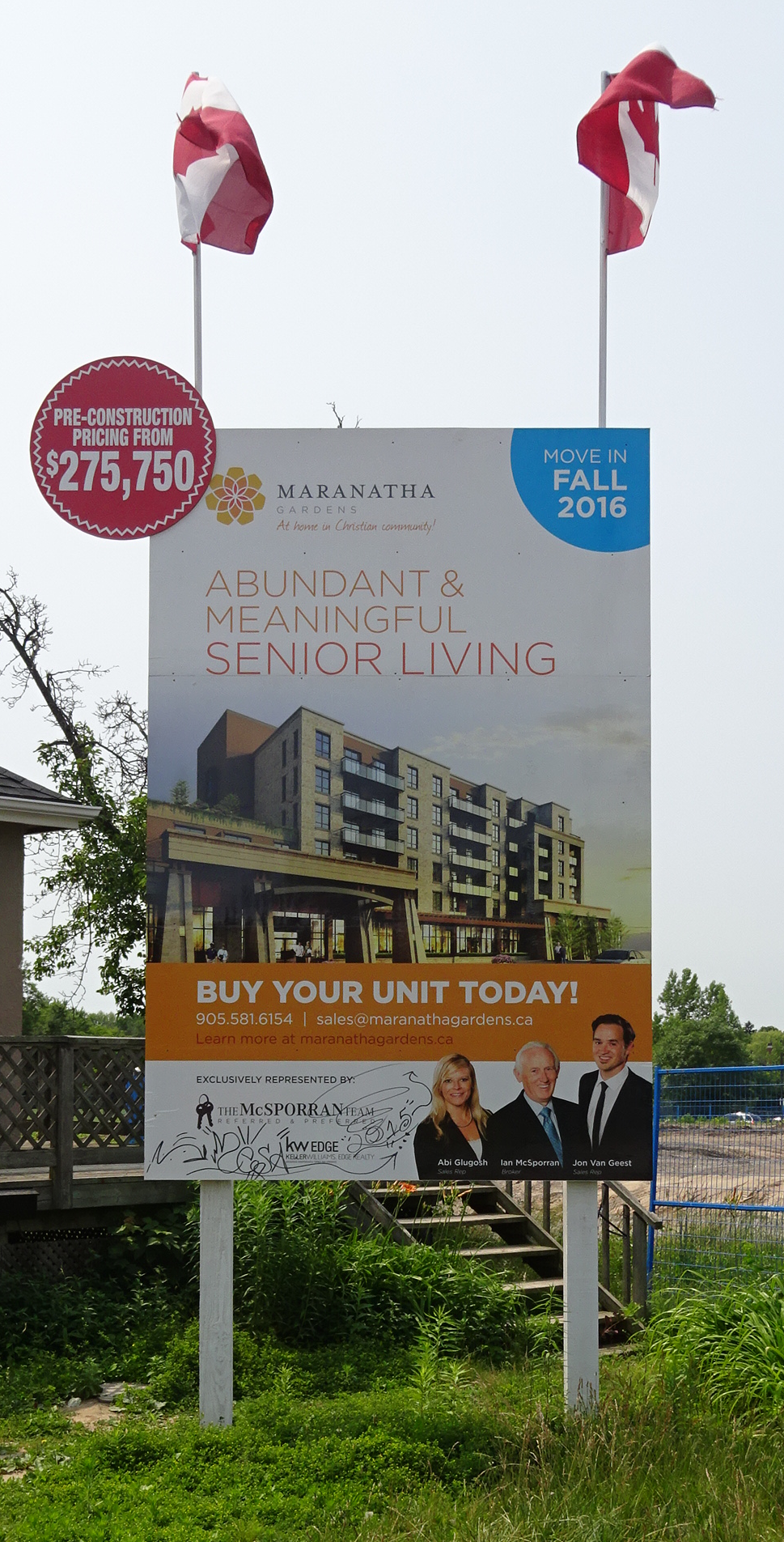 The what’s being offered for sale sign doesn’t look at all like what was approved at city council – why’s that? And there is a sign on the property offering units for sale – it isn’t a picture of the building that was approved – it doesn’t look anything like the plan that was approved at city council – so – which one is it ?

|
|

 Also be assured that my goal is the same as it has always been: to welcome and support development that respects our existing Official Plan and Zoning. As the staff report on this particular project states clearly – we do not need to overintensify this site or any other to achieve our goals and obligations under Places to Grow to intensify in the downtown area. I will continue to advocate on behalf of residents that we respect our Plan – and if it needs changing to do so within the overall context of an Official Plan Review which takes places every five years.
Also be assured that my goal is the same as it has always been: to welcome and support development that respects our existing Official Plan and Zoning. As the staff report on this particular project states clearly – we do not need to overintensify this site or any other to achieve our goals and obligations under Places to Grow to intensify in the downtown area. I will continue to advocate on behalf of residents that we respect our Plan – and if it needs changing to do so within the overall context of an Official Plan Review which takes places every five years.


































































































